The Theme – Mystery
For my final year at Milton Keynes College the theme provided for the Final Major Project (FMP) is “mystery”. Mystery is an extremely broad, yet fascinating subject. From century old tales of the paranormal, to unsolved crimes, to historical monuments and places – discovered or yet still to be discovered.
A mystery can manifest itself across various different forms, yet once a mystery is resolved, it loses its allure. Therefore, a mystery must always remain secretive or unsolved to maintain its legacy.
According to the Oxford English Dictionary, a ‘non-theological’ mystery is defined as:
“A hidden or secret thing; something inexplicable or beyond human comprehension; a person or thing evoking awe or wonder but not well known or understood; an enigma.” 1
Oxford English Dictionary
The Research Stage
27 February 2024
Once the FMP began, my thoughts immediately turned to the ancient world. To stories of places that have captivated me since childhood. I started researching those mysteries within the ancient world, such as the Seven Ancient Wonders of the World2, which are:
- The Great Pyramid of Giza
- Hanging Gardens Of Babylon
- Statue of Zeus
- Temple of Artemis
- Mausoleum of Halicarnassus
- Colossus of Rhodes
- Pharos (Lighthouse) of Alexandria.
But also those structures that exist outside of the Ancient Wonders, such as the Nazca Lines3 – over 1500 geoglyphs that span 500 square kilometres in Peru – as well as other ancient civilisations of south America, such as the Aztecs, the Incas and El Dorado – the ancient City of Gold4.
The other mysteries that interested me were the true, unsolved crimes of the zodiac Killer5, the strange disappearance of the crew of the Mary Celeste – a famous ghost ship found abandoned in the Atlantic Ocean in 18726, as well as several other mysteries surround objects that we have yet to determine their purpose or decode, for example cyphers and cryptic – some of which are centuries old like the Phaistos Disc from Greece7. The Phaistos Disc is circular clay artefact from the Minoan civilisation, covered with mysterious symbols8.
Alongside mysteries – which have been observed and contain some valuable evidence for their existence – I looked into myths. Myths are the tales of folklore and legends which could also be suggested as a form of mystery.
I turned my focus to the myths of strange creatures and humanoids such as Bigfoot, the Loch Ness Monster, the Wendigo9 (a malevolent spirit or creature from Algonquian folklore, often depicted as a cannibalistic monster with an insatiable hunger for human flesh), and the Skinwalker10 (a figure from Navajo folklore believed to be a witch capable of shapeshifting into animals), all of which share an air of a mystery.
Many of these myths of strange creatures have reports of sightings but most have little or no evidence and with no confirmed or authentic footage, their tales continue to captivate many people around the world.
However, just because something is recorded several times in history, such as The Loch Ness Monster, or validated by recognised scholars and so-called trusted sources, e.g. The great philosopher Plato describing and mapping the location The Lost City Of Atlantis11, it very quickly becomes part of modern culture and perceived to be true, yet the truth is it still remains a mystery.
For my pitch, I narrowed the focus down to the three mysteries that intrigued me the most. These were:
The Hanging Gardens of Babylon
The Mary Celeste
The Wendigo
The Pitch
Feedback
Below is a number of quotes I received as feedback.
“Took the time to define the theme showing an understanding of the context. Gave a good range of examples on what you found mystery to be.”
“Good range of research that you looked at surveys and interviews. Looked at both peers in and out of college. With this you came across problems that you solved and used to inform and develop your ideas.”
“All ideas are different and interesting. Felt the second and third idea where the most intriguing although first idea is good these two ideas would be the most challenging.”
“Chosen idea three, idea of Babylon, great way to be creative. Chosen because less people know about it which is a good idea.”
“Talked about challenges and what skills you want to develop as part of this project”
“Discussed time management, could use AI to help theorise what a hanging garden could look like. Could you potentially take it down a fantasy route”.
With the feedback provided during my pitch I will explore the use of AI tools to help provide concepts for what the hanging gardens of Babylon could look like. These will only be used to quickly generate ideas and will not be used to implement in the final product nor will they be copied during the 3D render.
Time management
Below is a Gantt chart of my proposed time management
I will be following these milestone closely. If I require more time I have allocated an element of contingency of an extra 24 hours to make any adjustments or improvements. This will aid my focus and create the best output possible for the FMP.
Babylon Research
14 March 2024
The History of the City of Babylon
The Hanging Gardens of Babylon were believed to have existed within the Babylonian empire over 4000 years ago and situated in the city of Babylon, located in Mesopotamia along the Euphrates River12, which is now modern-day Iraq.
Between 700 BC and 600 BC, Babylon was the largest and wealthiest city in the world and would compare in size as large as modern-day Chicago13. Its immense wealth allowed for the construction of monumental structures, including massive towers and highly crafted architecture. This included the fabled Hanging Gardens, filled with lush greenery and vegetation and were said to have been built by King Nebuchadnezzar II for his homesick wife, Amytis14, to remind her of the mountains and landscapes of her homeland.
In 539 BC the city was conquered by the Persians under the leadership of Cyrus the Great. Although Babylon remained an important administrative centre, it gradually declined in prominence. In the centuries that followed, and after a series of attacks and sieges, it eventually fell into ruin and the exact location of the Hanging Gardens became lost to history.
The Gardens of Babylon
Arguably the most legendary piece of the ancient city are the hanging gardens themselves. They have captured the imagination of generations. Described in ancient texts as an imposing, tiered building, covered with many different varieties of plants and exotic wildlife. It is because of its suggested beauty and engineering innovations that it earned a place among the Seven Wonders of the Ancient World.
For me, what also makes the Hanging Gardens particularly intriguing as a mystery is its location. Despite multiple accounts, no physical evidence of the gardens has ever been found. While Babylon itself has been extensively excavated, revealing important discoveries such as the Ishtar Gate and the Tower of Babel15, the garden’s location is still unknown.
It has been speculated that the gardens may have been a series of tiered terraces and constructed using an irrigation system to support the variety of plant life. Others suggest that the entire concept of the Hanging Gardens may have been symbolic or exaggerated over time.
While they are extensively documented in ancient texts, the search for the Hanging Gardens has led researchers to explore different theories and possible locations. Some experts have proposed that the gardens may have been located in Nineveh16, the capital of the Assyrian Empire, rather than Babylon. This theory is supported by archaeological findings suggesting the presence of extensive gardens and irrigation systems in the vicinity of Nineveh.
The confusion surrounding the Hanging Gardens has sparked debate among historians and archaeologists. While some believe that the lack of physical evidence may indicate that the gardens never existed, others argue that time has erased all traces of this ancient city. Therefore, the continued mystery of the Hanging Gardens has led some to compare it to other legendary lost civilisations and landmarks, such as Atlantis.
It is also a possibility that the Hanging Gardens of Babylon were real but were never completed before the fall of Babylon to the Persians. Construction may have started but the gardens themselves may have never been completed.
The Architecture
Babylonian architecture was characterised by its innovative use of materials and distinctive designs. They used materials such as Cedarwood and mudbrick to create structures that were not only practical but also appealing to look at17.
Materials
Cedarwood: Sourced from Cedrus trees native to regions like the Himalayas, the Mediterranean, and the Atlas Mountains of North Africa18, it played a large role in Babylonian architecture. Cedarwood is rich brown colour and with a soft texture. This means it worked well in the buildings of Babylon. Its malleability allowed the builders to turn it into elaborate features, including grand arches, ornate doors, and other decorative elements.
The use of Cedarwood not only provided structural stability but also added a touch of luxury to buildings, reflecting the wealth of the Babylonian people.
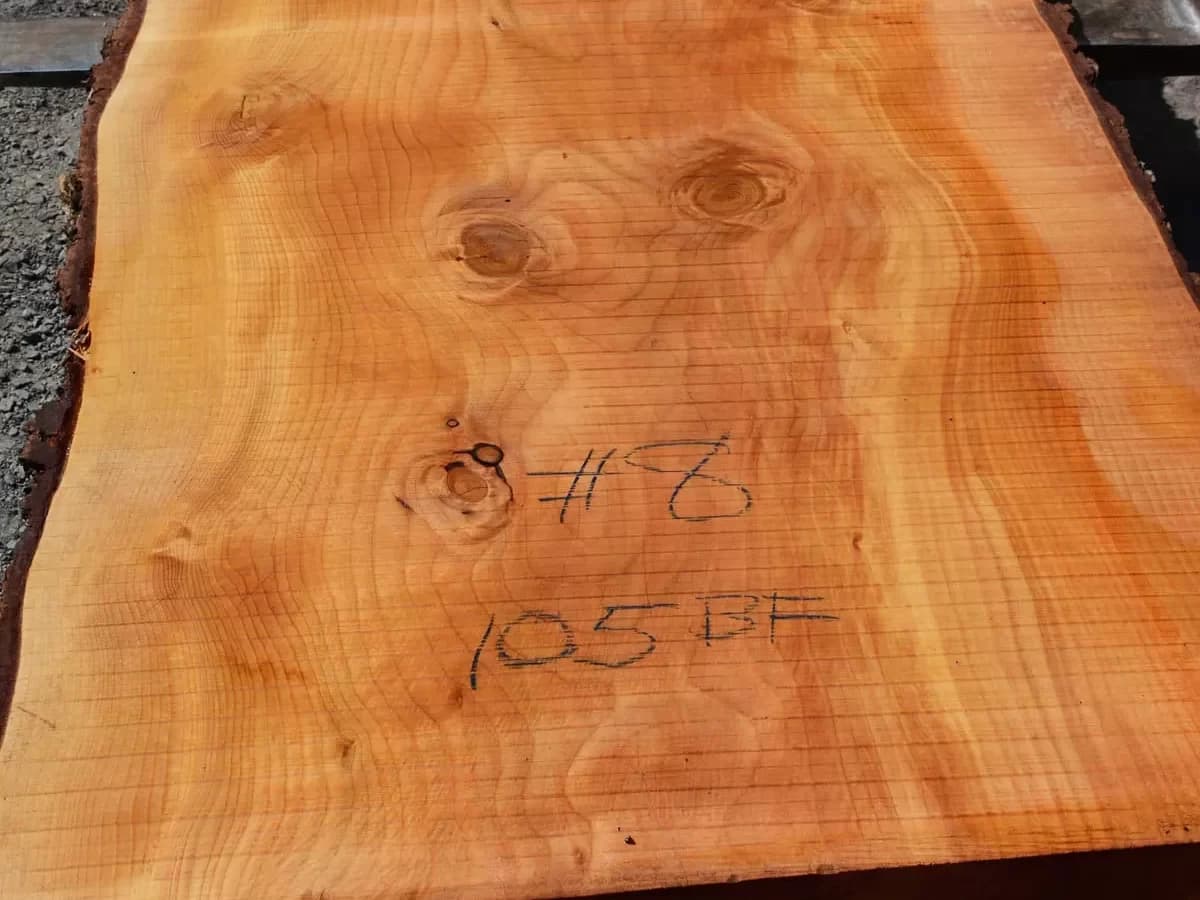
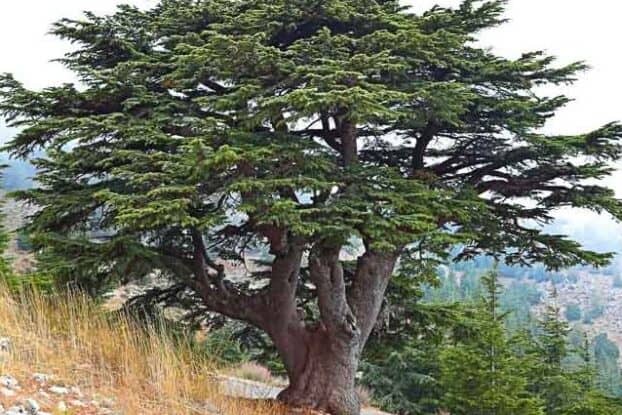
Mudbrick: another fundamental building material as it was readily available and easy to work with. Made from a basic mixture of mud and straw, mudbrick structures were durable and well-suited to the climate of Mesopotamia. The builders used mudbrick to construct walls, buildings, and fortifications, creating a distinctive style with its earthy tones and textured surfaces.
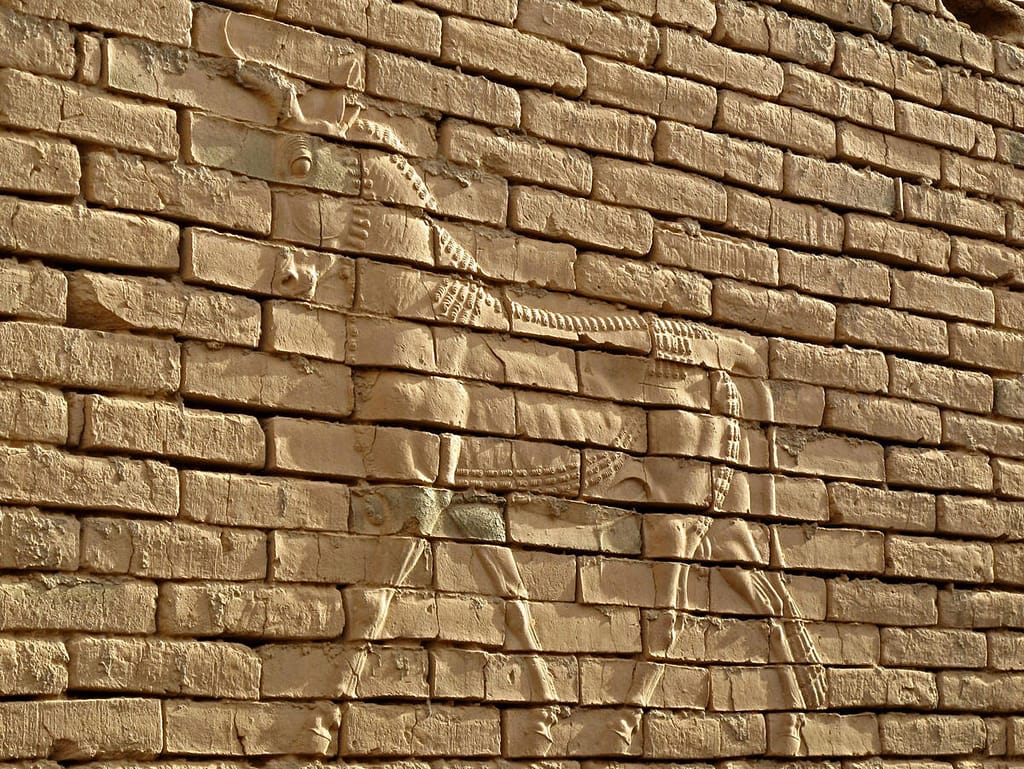


Style of architecture
Babylonian architecture featured thick walls and stepped terraces for their temples, creating a striking visual effect19.
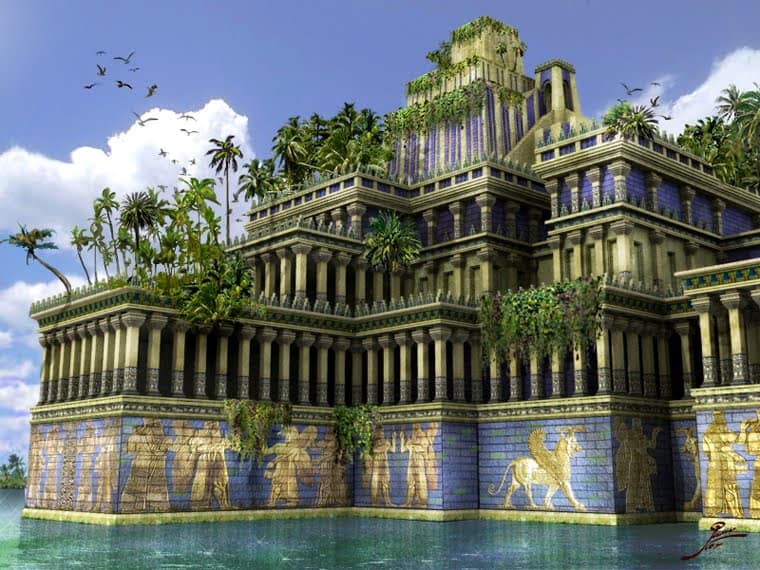
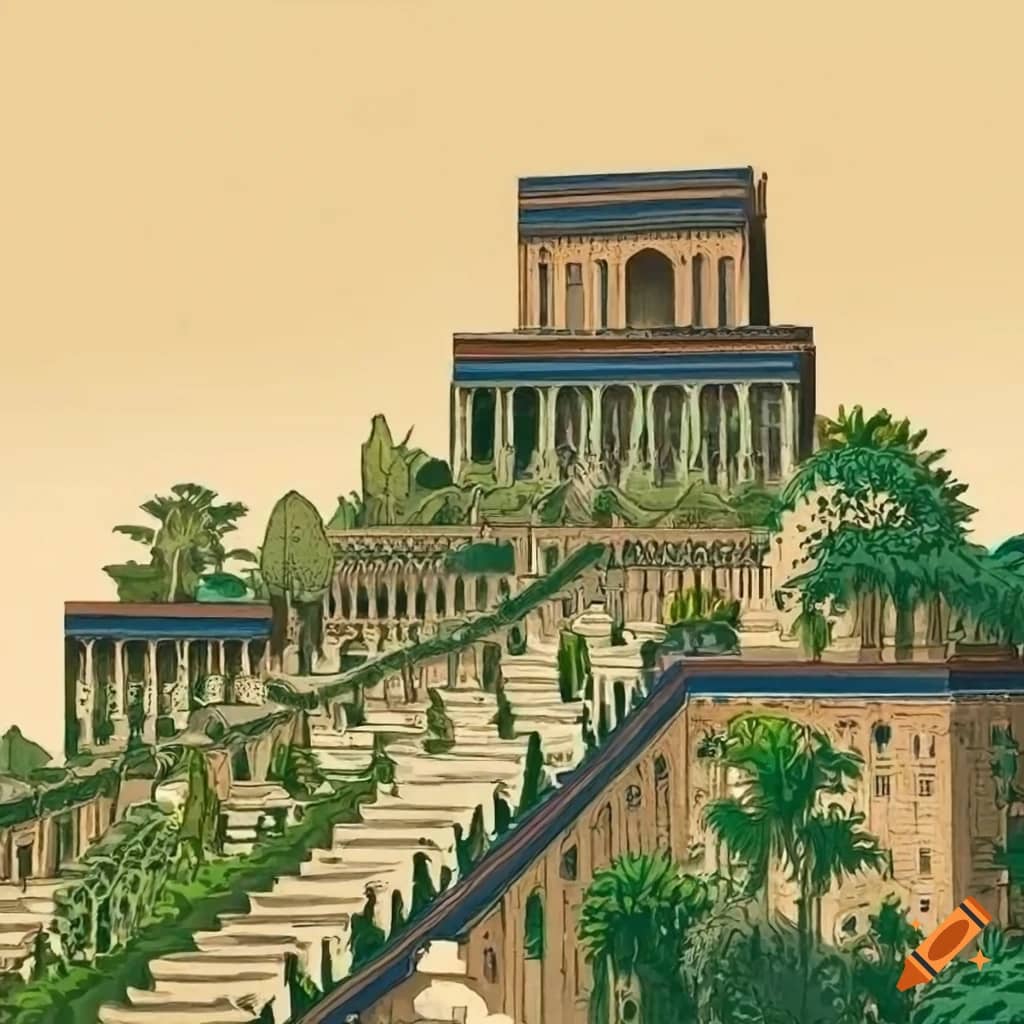
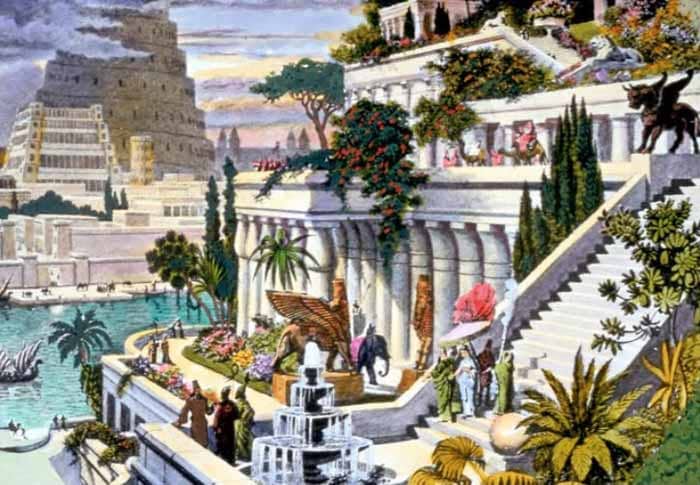
Within these buildings, there were vaulted ceilings and large domed roofs to create spacious interiors and used pillars to provide structural support.
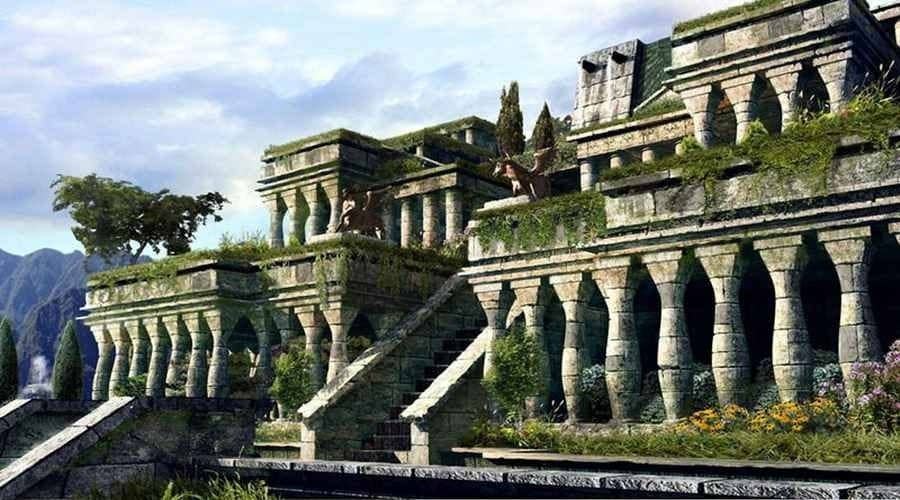

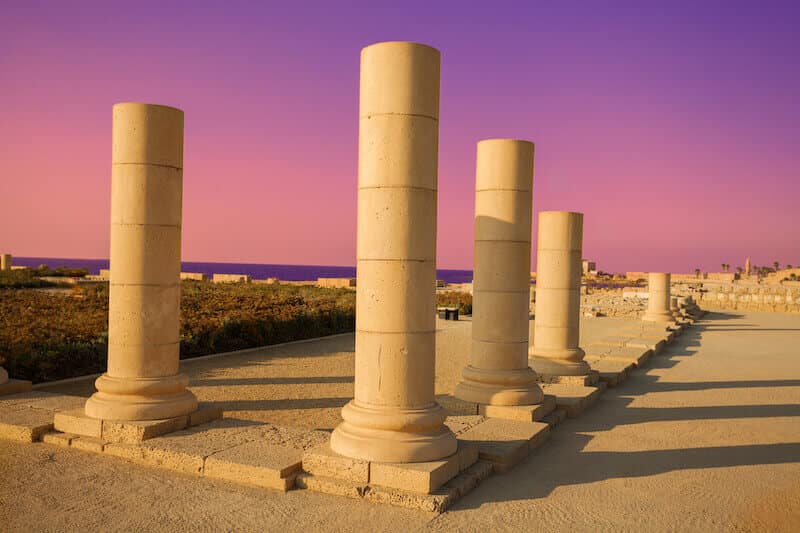
Overall, Babylonian architecture can be defined by its strong bold forms and highly skilled craftsmanship



Plants of Babylon
Babylon was located in a very fertile part of Mesopotamia. It has a rich diversity of flora that flourished along the banks of the Tigris and Euphrates rivers.
At the time of the Hanging Gardens of Babylon, the region boasted approximately 3300 different species of plants and flowers documented in present-day Iraq. Many of these plant species were not exclusive to Iraq but were found throughout the broader region, including neighboring Arabic countries. Iconic flora such as the Gum Arabic tree and the acacia Nilotica were prevalent across Mesopotamia20.
Some of the more common flora were:
- Cypress
- Ebony
- Pomegranate
- Plum
- Walnut
- Myrrh
- Terebinth
- Grapes and vines
- Juniper
- Fir
The gardens were described in ancient texts as breathtaking and are said to have included a huge abundance of plant species from across the known world. While it is difficult to tell the exact type of plants used, it is believed that they may have featured a diverse collection of trees, shrubs, and flowering plants that still thrive in modern day Iraq.
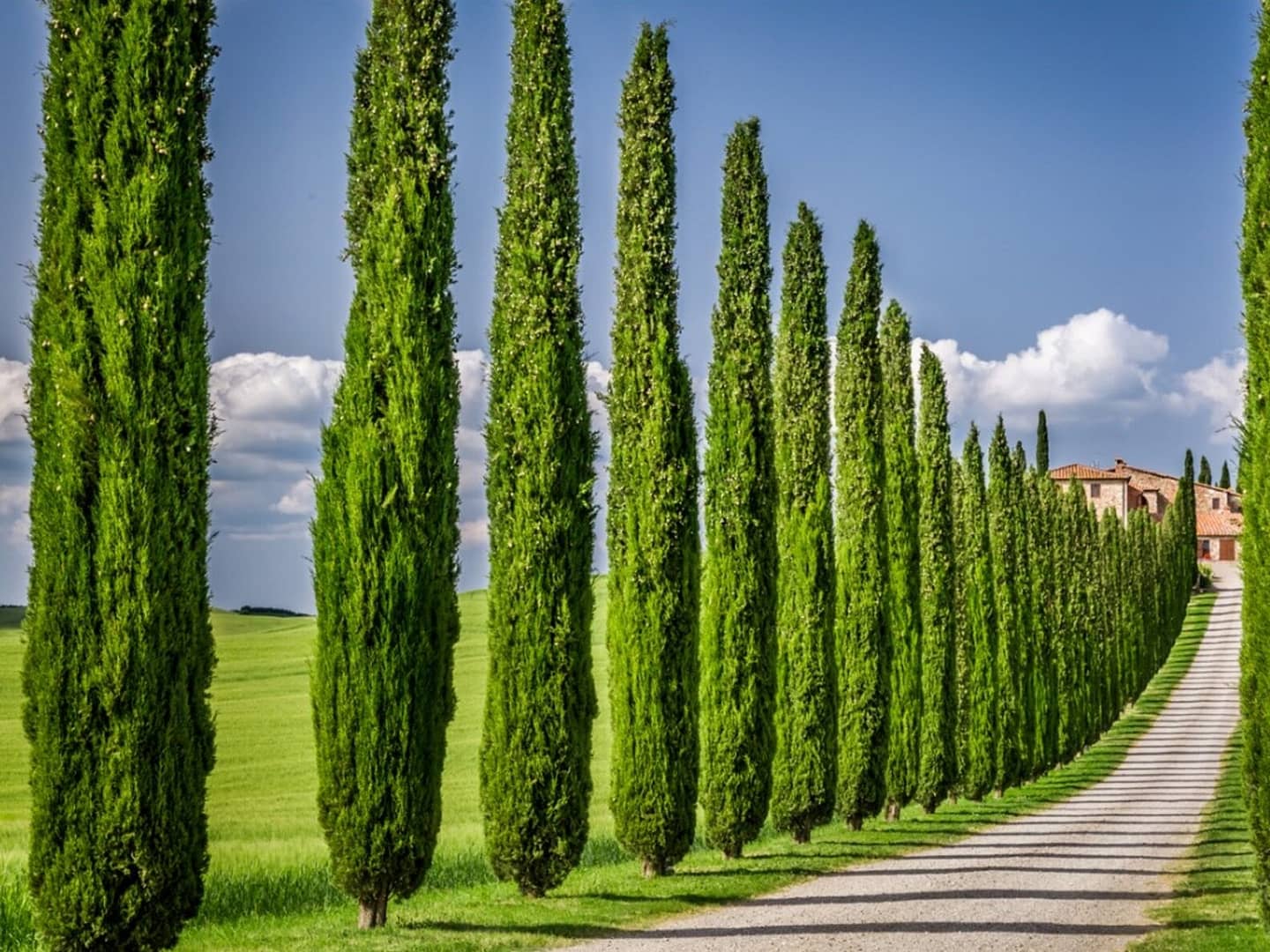

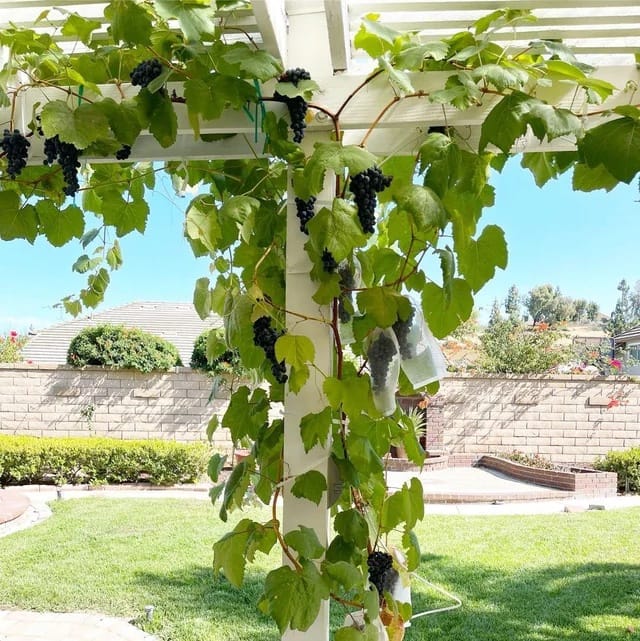
Babylon in Modern Media
Although Babylon is one of the Seven Wonders of the Ancient World and its presence is known to many people, it surprisingly hasn’t featured much in the media and modern culture. Only a few movies and TV shows have referenced or included Babylon.
One such example is the Movie ‘Eternals’, created by Marvel studios, which fictionalised the gardens creation and purpose for existence – in this case the holding bay/hiding place for a space ship21. Apart from that, there have been very few movies that have spread awareness of the city and its architecture.
An action-adventure game ‘Babel Rising’ was produced in 2009 which centred around the legend of the tower of Babel. The main aim of the game is to prevent humans from building the tower. There are only a handful of references to the gardens of Babylon in this game and so did not provide the audience with an understanding of its existence and purpose22.
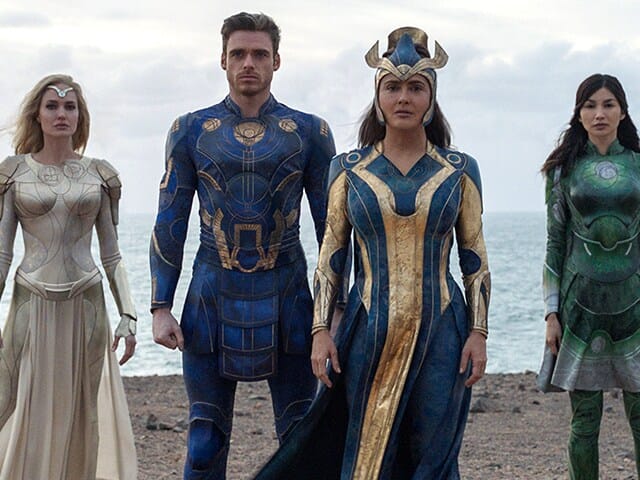

Despite the absence of extant Babylonian texts or any archaeological evidence definitively proving the existence of the Hanging Gardens, references in numerous historical accounts and literary works attest to their existence. However determining fact from fiction and original stories from tales handed down over millennia, makes recreating the Hanging Gardens of Babylon an interesting and exciting challenge for my FMP.
This research, especially into modern media references, provided me with more reason to create a product surrounding the Hanging Gardens of Babylon that were true to the history and documentation of the building whilst also being my unique interpretation of it and how they may have looked.
Primary Research
For Primary research I decided to interview a group of people from both inside and outside of college on my Babylon Idea and what they believe it would look like. I decided to do people from different areas due to a range of voices as I might encounter a challenge where if I only interview people form college, they would all have the same ideas but if I interview people outside of college I will have a range of ideas that will be useful for y product. Below are my responses.

This response Helped me create an idea of ancient, beautiful architecture as well as aiding me in ideas of abandonement which I will use later on with vines and wildlife growing in and around the building.
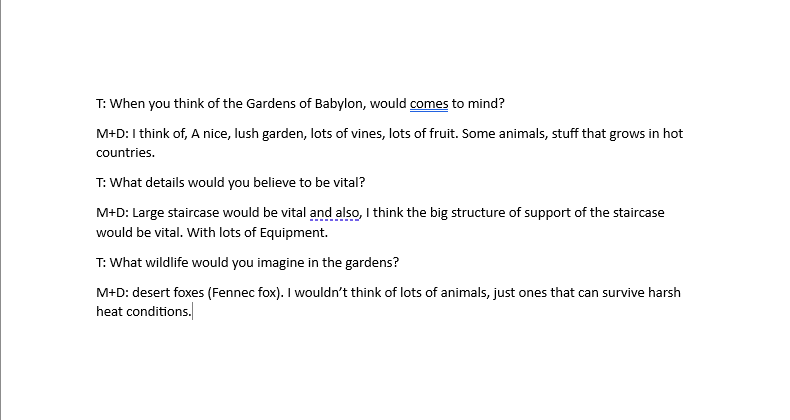
I then interviewed my parents which spoke to me about fruit and a lush style. They also mentioned a staircase which is common in ancient architecture as well as desert wildlife which is beginning to seem common now.
I believe that with my time schedule, creating wildlife could be time consuming and that I should focus on the main piece instead, however I will still consider these additional details in my production time allows.
The challenges
Throughout the FMP I fully expect I will encounter hardware challenges such as system errors, corrupted files and render duration as I expect my FMP to be quite complex with the amount of meshes I will be using. Apart from render duration, hardware challenges will be somewhat out of my control due to the limitations of the computers provided within college as well as the limitations of the my personal computer.
To counter these challenges I will ensure that there are constant save points as well as backups that are uploaded to One-drive as well as being kept on the computers. I will also name each file save differently according to the progress, In case one file gets corrupted or deleted, this way I will be able to back-track to a previous safe point in my production without having to restart completely. I will also keep my WordPress post updated regularly. In the extremely unlikely event that every version of my product becomes corrupted, I am confident I have the systems in place so that I can copy the work I have produced or, if I ran out of time, I could use WordPress as evidence of my work if I couldn’t submit a final render.
Some of the personal challenges I may encounter could be procrastination; burn out; distraction; and lack of or too much ambition. These are mental challenges that I will need to combat myself and find ways to prevent these.
To prevent procrastination and distraction, I will ensure that whilst I am within college I focus solely on my work but when I am at home I will set break times for me to relax and cool down which should hopefully prevent burn out. I plan to also utilise my timeline as much as possible to make sure I am hitting key milestones to keep my motivated and on track. I also need to be aware of not getting too distracted by detail and get carried away with my ambition so I will try and build detail as I go and not straight away to prevent facing challenges with the hardware. I shall also remove all distractions when I am working at home by removing phone, consoles and any other devices from my room to maintain my focus.
Concept art
20 March 2024
The next stage of my final major project is to create concept art for my 3D animation, this will aid in my production as I will be able to have references I can use. It will also allow me to experiment with different ideas before choosing on one.
I began by using AI generated photos on photoshop with the prompt “Babylonian gardens” to gain ideas on what could be done. I worried that the systems wouldn’t work and could provide something completely random. If so I would have to re-adjust my prompt and try again or use other peoples interpretations of the building. Fortunately, it did work with the prompt, below are some generated photos produced.
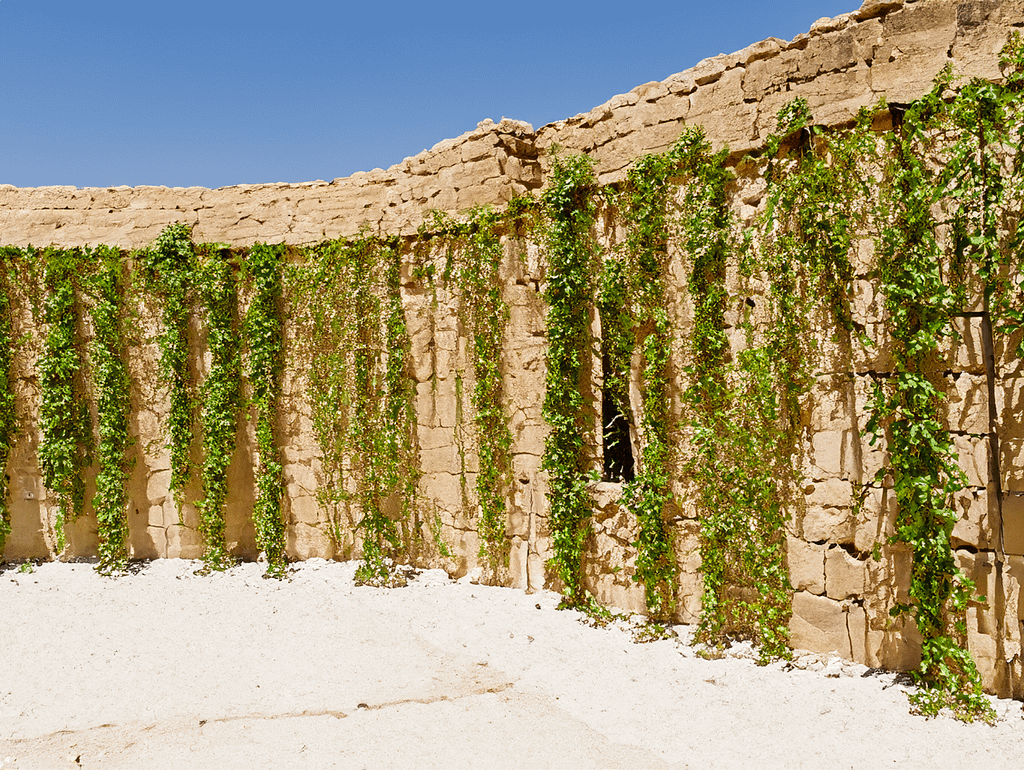
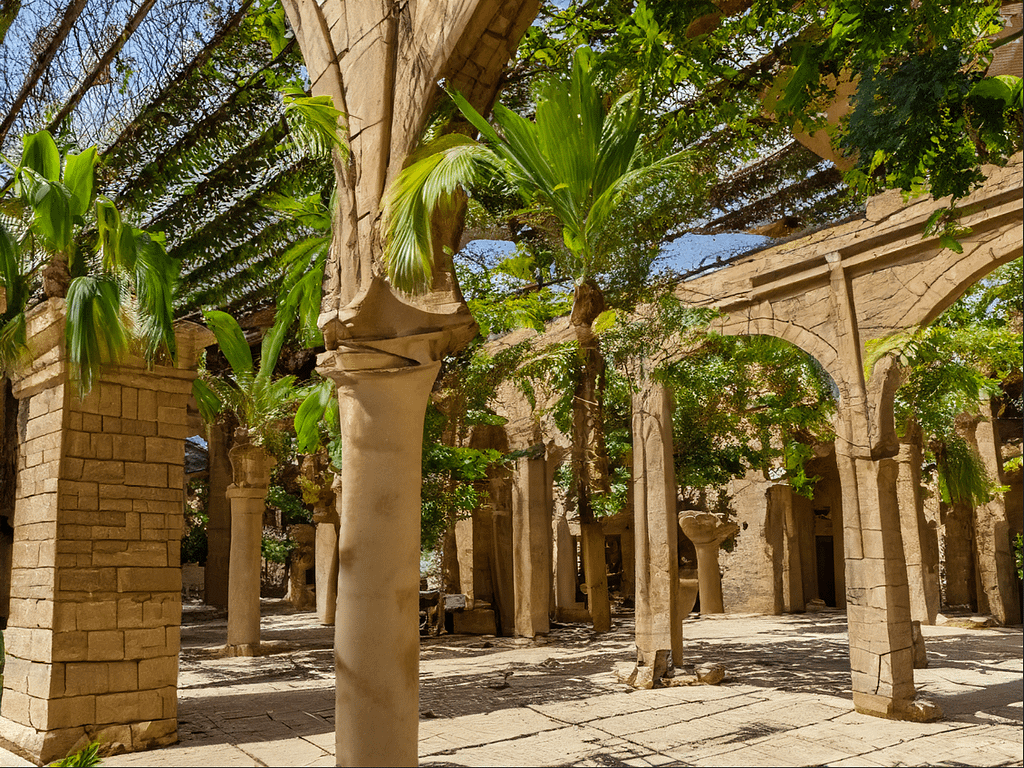
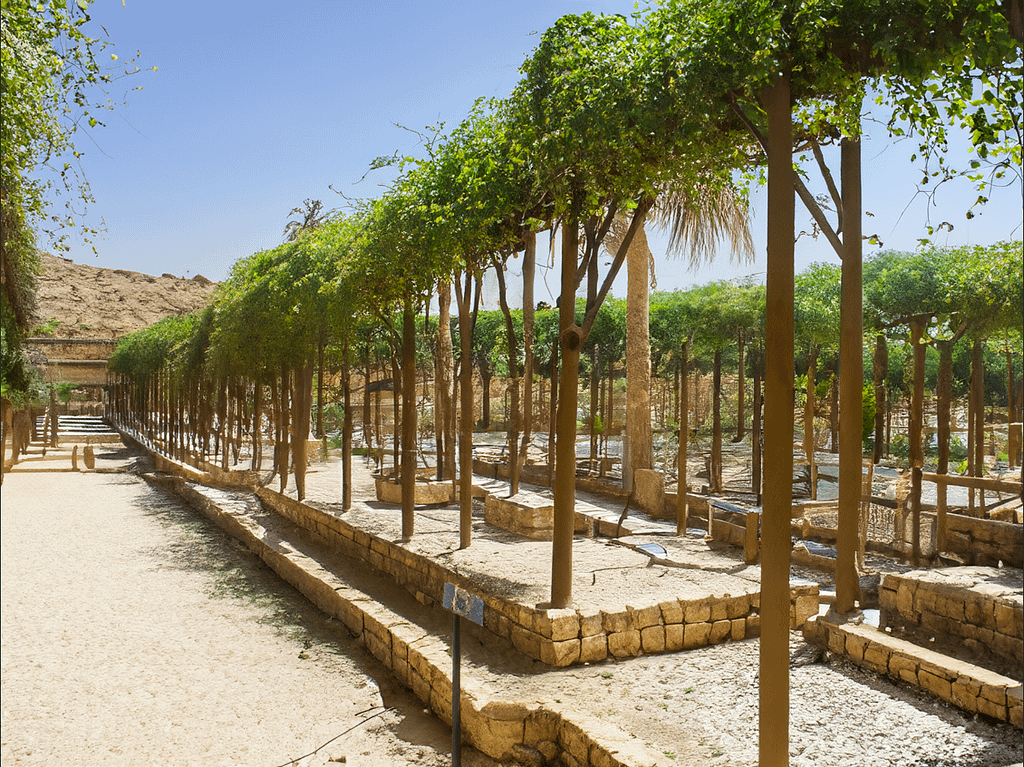
I then explored another another Ai image generation tool called Midjourney. This produced some more spectacular results as I tried different prompts in this case “a view of the hanging gardens of Babylon entire complex, showing the entire structure”. These AI generated images are solely for inspiration and idea generation. I will ensure that it will not be claimed as mine.
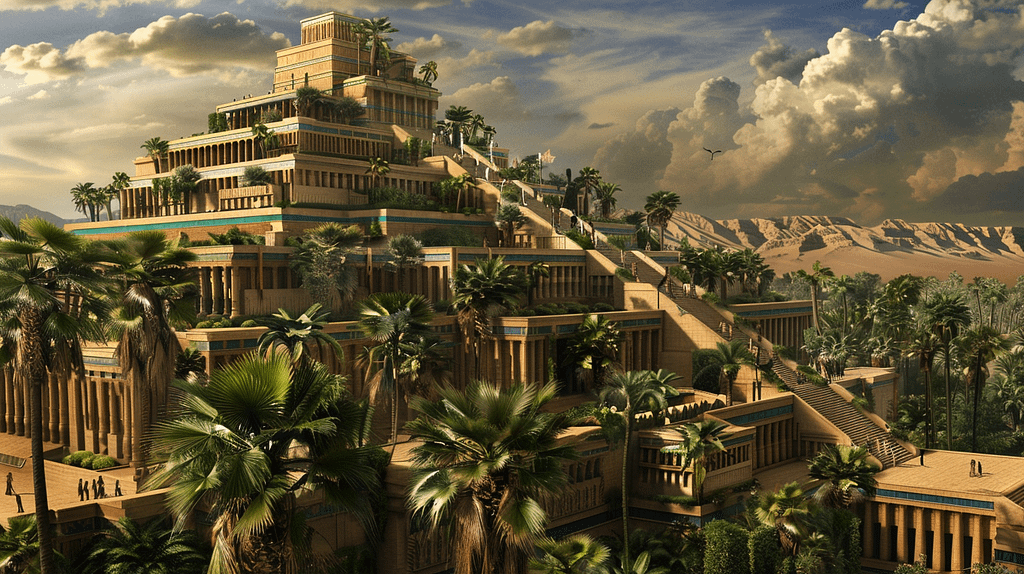
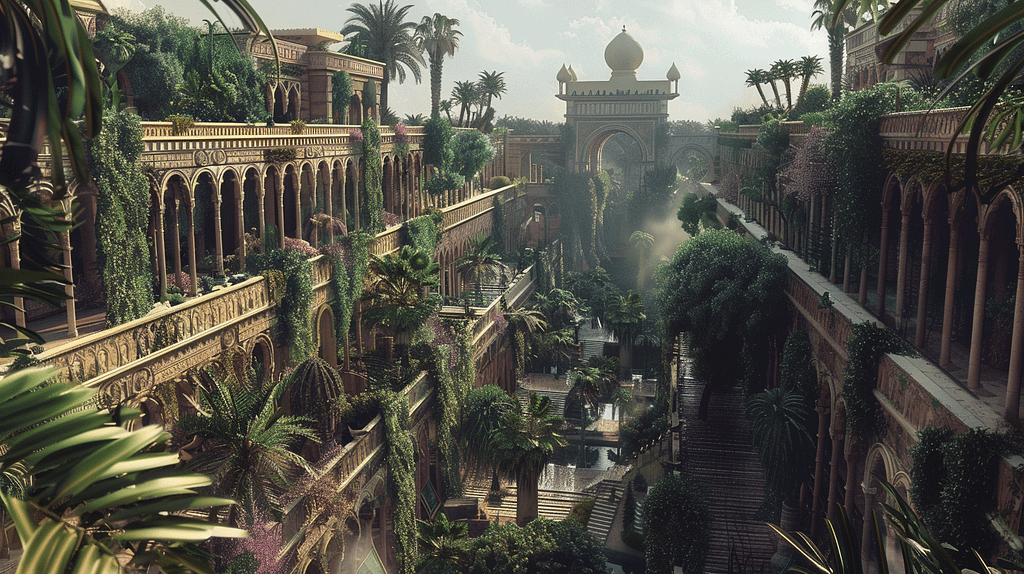
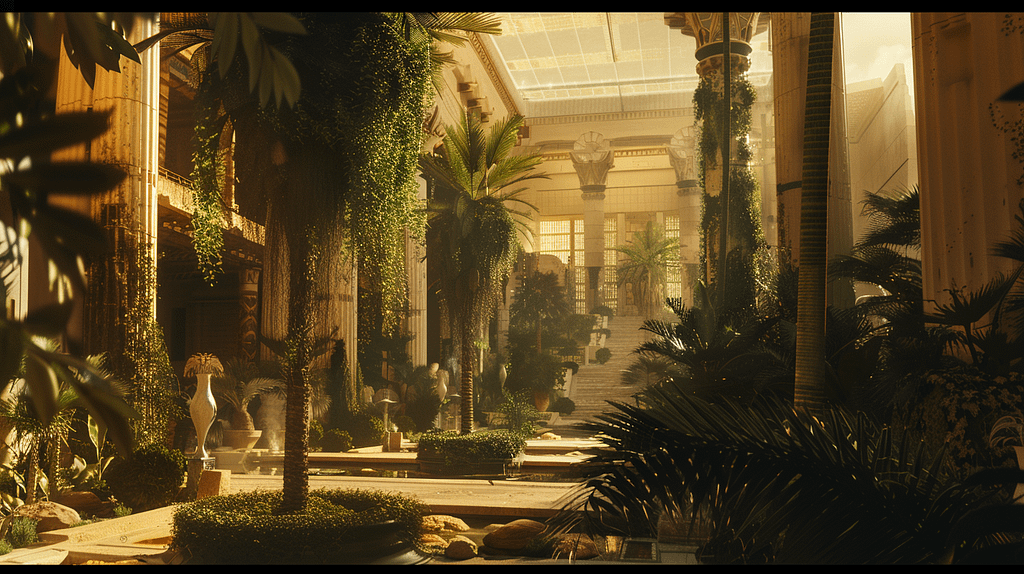
With the research and archeological records, the artists impressions and AI generated photos I started to build an an idea of the Babylonian architecture more clearly such as the walls, the support beams and the flooring used. I also gained an understanding of how the mudbricks were conveyed and how the pillars were possibly designed. It also showed me how the flora could have flowed through the building, such as the vines and how they hang and grow in and around the cracks within the walls.
Feeling inspired from what I have seen and read, I began drawing concepts myself using a combination of pencil sketches and Photoshop. When I first created my concepts I wanted to create a Mayan-style pyramid structure, However without the stairs that reached to the top layer, I went for entrances all around the base layer which would have light exiting the archways. I wanted to go for a simplistic but effective design as I considered the fact that it would have been extremely difficult to build this monumental structure.
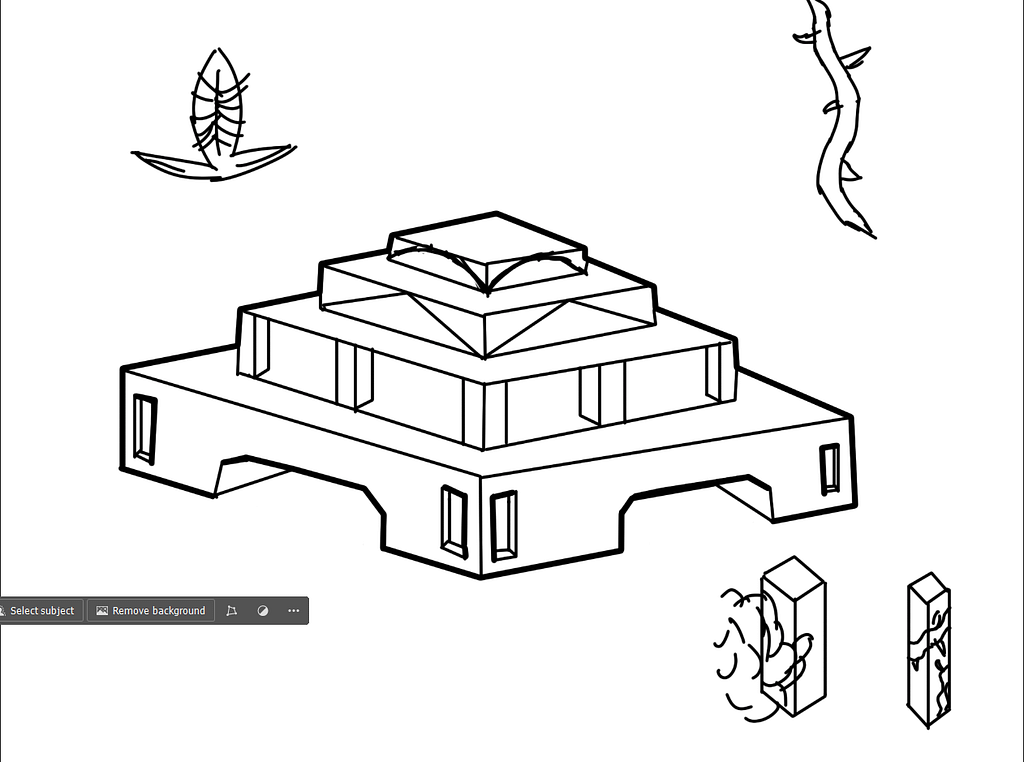
I developed ideas for the towers with different themes and structure, each one unique to the other. This aided me in what themes could work with the building itself. I decided to go with the style on the far left as it was simplistic yet looked unique. It also looked somewhat similar to a steel bar in my opinion by having the small insets on the sides of the building. This idea will be used in my final design as I believe it looked the best out of all of them.
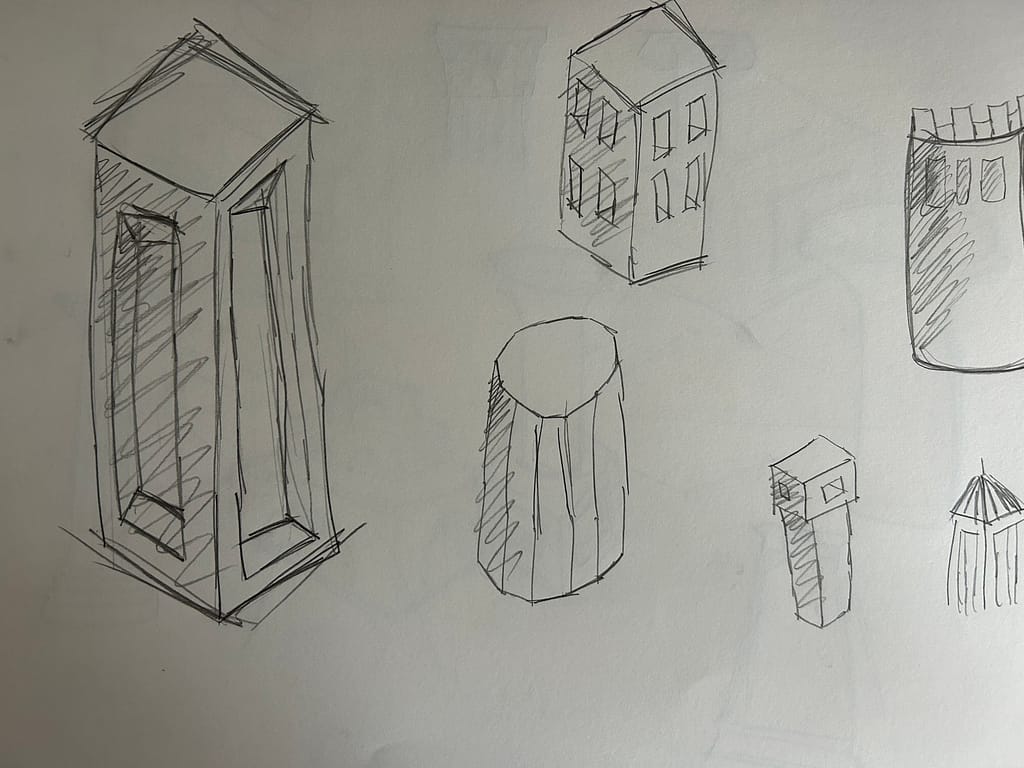
After the towers I began working on the pillars that would be used at the entrance of the Gardens as well as within the building itself. I researched different styles of pillars from different times and places in history and mimicked them in my own styling. I really liked the spiral and petal styles, however I knew that both would be very time consuming to produce them and it could take up too much time creating them when I needed that time for the rendering and flora which would actually cover most of it anyway.
In the end I decided to go with the standard circular style with a cube base that was similar to the tower, keeping it in style and giving the building a unique look but also bold and strong as referenced in the ancient texts about the buildings of Babylon .
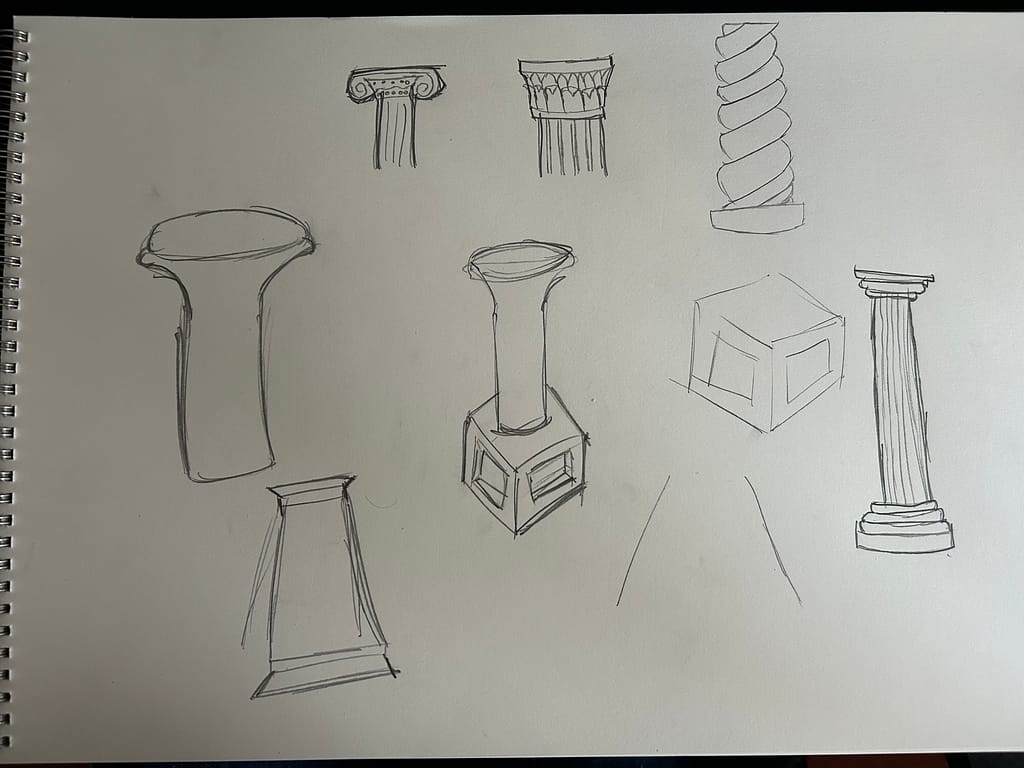
Afterwards I began considering different designs on the plant life and how I would incorporate them into the architecture such as how the vines would wrap around the towers and pillars.
The vines would be the main piece of the work as they would be everywhere over the building and would provide the audience with awe-inspiring imagery of the magical growth within a desert where very little life grows now.
I decided that the tree would be tall but the leaves would create a canopy style over the garden, covering the roof in shade. I also created ideas for the vine leaves and decided to go with the style that had three separate tips. I adapted the idea into several different choices and how it would look connected to the vines.
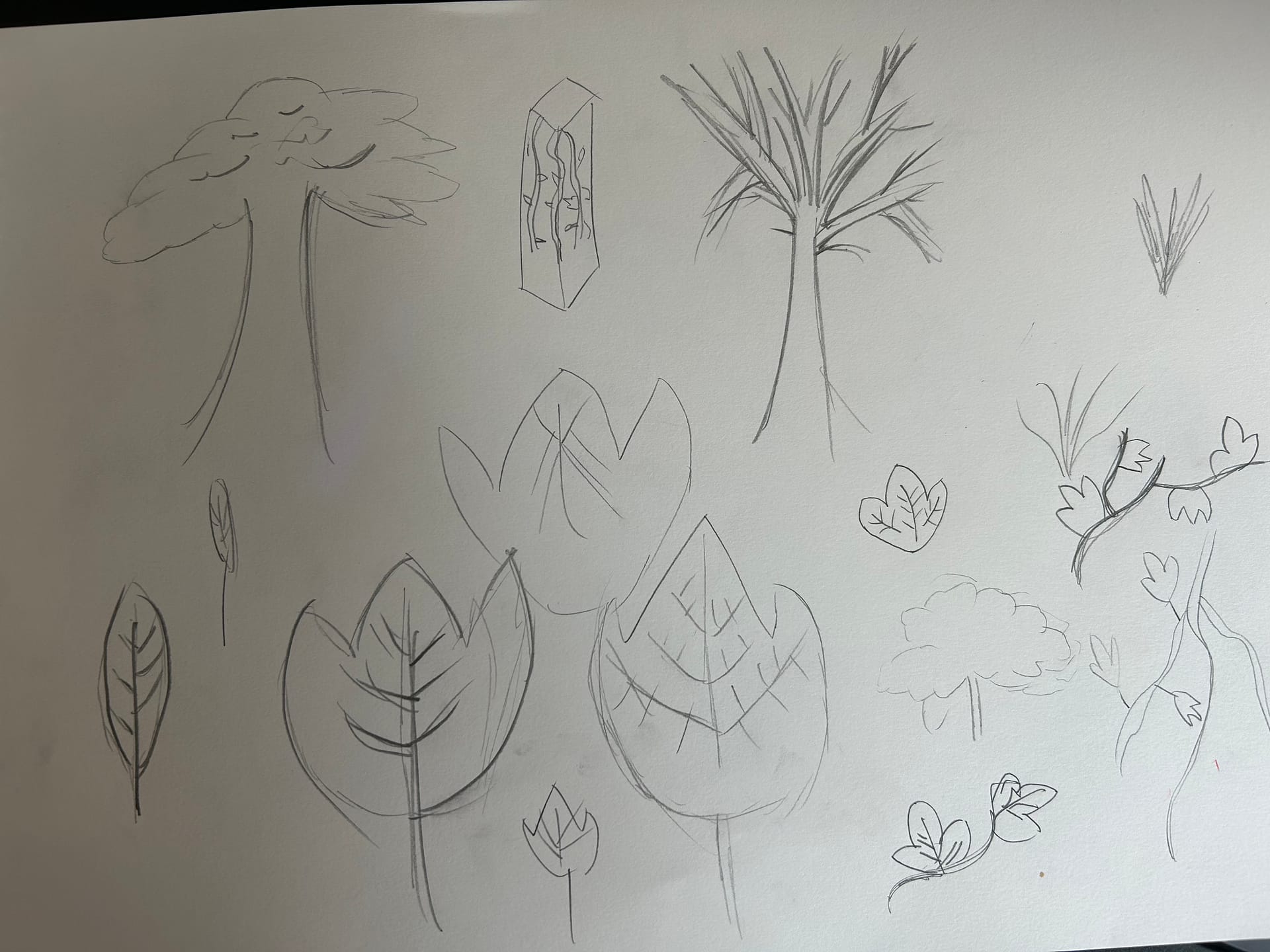
With this in mind I created a tower and a corner angle of the building with simple, bold colours to understand what the materials may look like. I implemented the vines into this concept properly to understand and picture how it would look and how it would act as it went down the layers of the building.
I decided that the corner tower could be used for trees and shrubs to grow in and around it, sort of acting like a large plant pot. Once the concept was finished, I decided that the colour for the bricks was the right tone and that the side towers would be a great addition, Adding a tiny bit more detail to the tower and giving it more life.
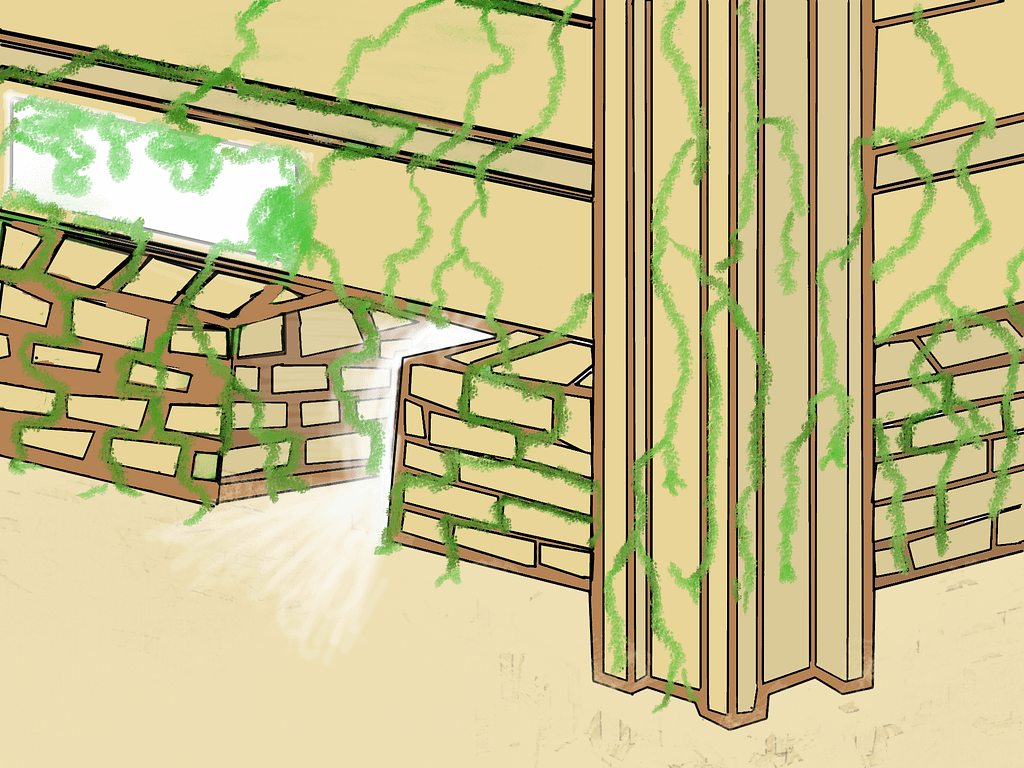
Finally, I created a birds eye view to aid me in getting the dimensions correct. It will have two towers on opposite corners as well as a central area on the roof that acts as a sort of balcony with flower beds and seating on top of it. I believe these concepts have provided me with the ability to get my ideas on a picture and will help as support for my final product.
I added light emitting from the doors as a way to add to the magical concept as well as the mystery of what is inside it.
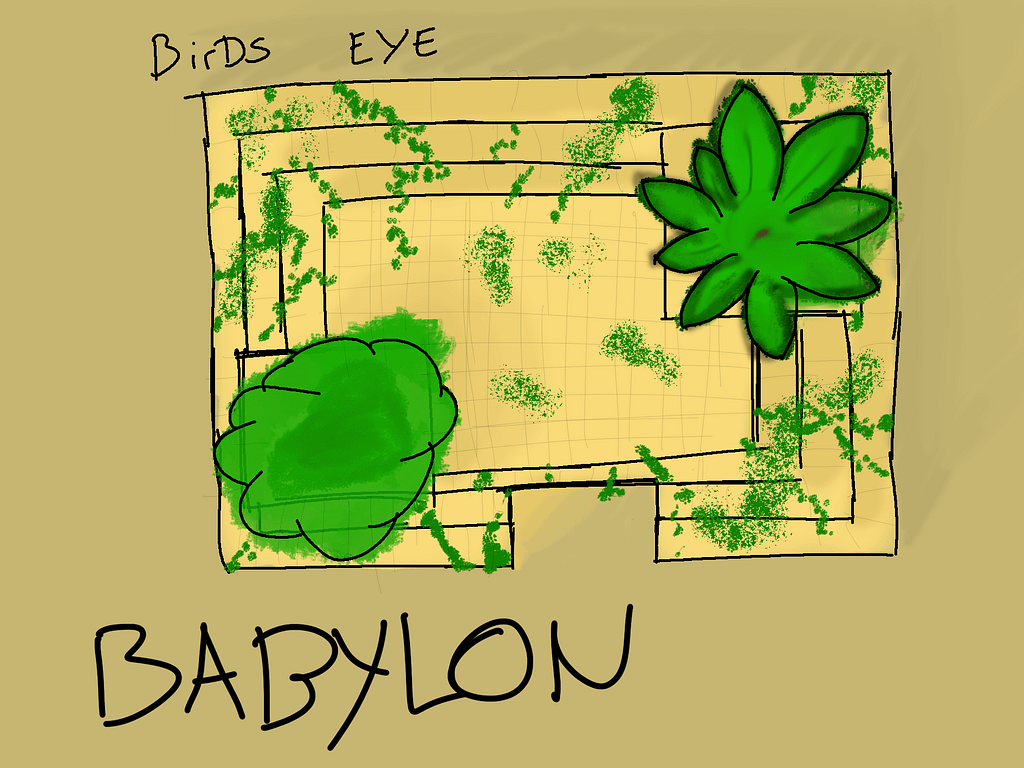
WWW: My ability to create simple sketches from different angles to aid the production piece as well as different ideas within the smaller details, ensuring that I have a variety of options if I was to change my decision midway through the production
EBI: If I could create more detail and angles including interior shots as well as texture ideas and mood-boards for style choices.
The Production
28 March 2024
On the fourth week of the FMP I began my main production piece. I started by Modelling the base layout of the building. I added details in the walls that mimic the old architecture within Babylon.
My biggest worry with my production is the system requirements, throughout my time within this course I have encountered limitations with the system that has cause crashing, system resets and even complete system shut downs that have not saved my progress. Luckily though I haven’t encountered an error so far but as a way to counter this if I ever do, I will constantly save my progress and create a back up at major points and before a high cpu usage event.
I believe it went quite well but I had trouble with modelling some sides which I have had to leave for some time until I could figure out how to fix it. Below are three short time-lapse videos of my progress which shows what I have produced so far.
Next I began working on the environment, I used a built-in add-on within Blender called Environment. It allowed me to create my own landscape with hills and a river.
I then added a hair particle which I would use to make patches of grass dotted around the landscape as it is the only suitable particle emitter that mimics grass better than other types. I added around 10,000 hair particles each with children which helped to produce the grass clumps. I altered the position of the hair so it was arched and its position was irregular which created a more lifelike style.
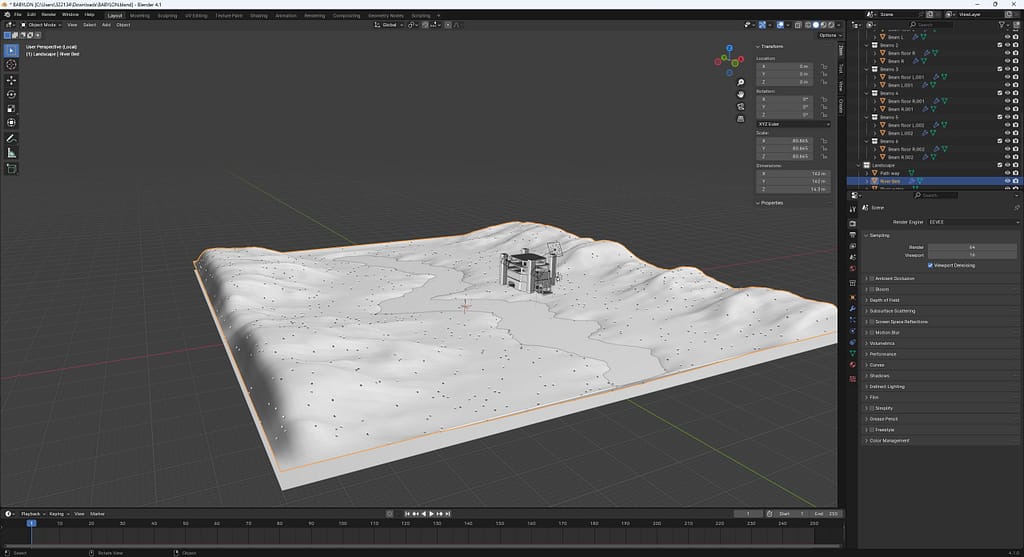
Afterwards, I began texturing the environment, I experimented by adding different waves and noise textures with different qualities and then introduced a colour ramp to create a sand dune texture. Finally to provide more detail I added a bump node for it to create an illusion of different heights within the texture itself as Blender uses the different colours to decide how light would reflect off different surfaces. I experimented with different styles and ideas but decided to go for the one shown below. Underneath it is the other textures I experimented on.
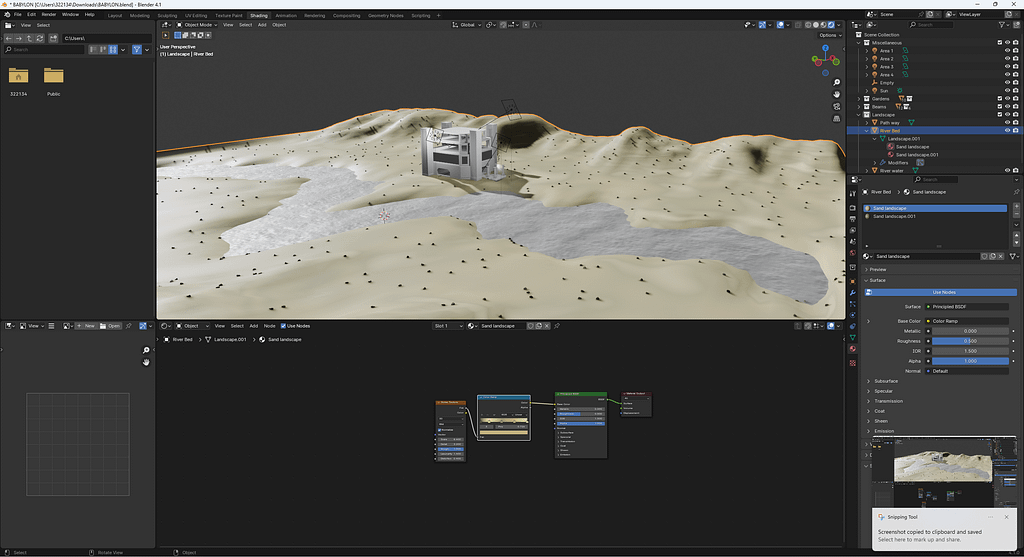
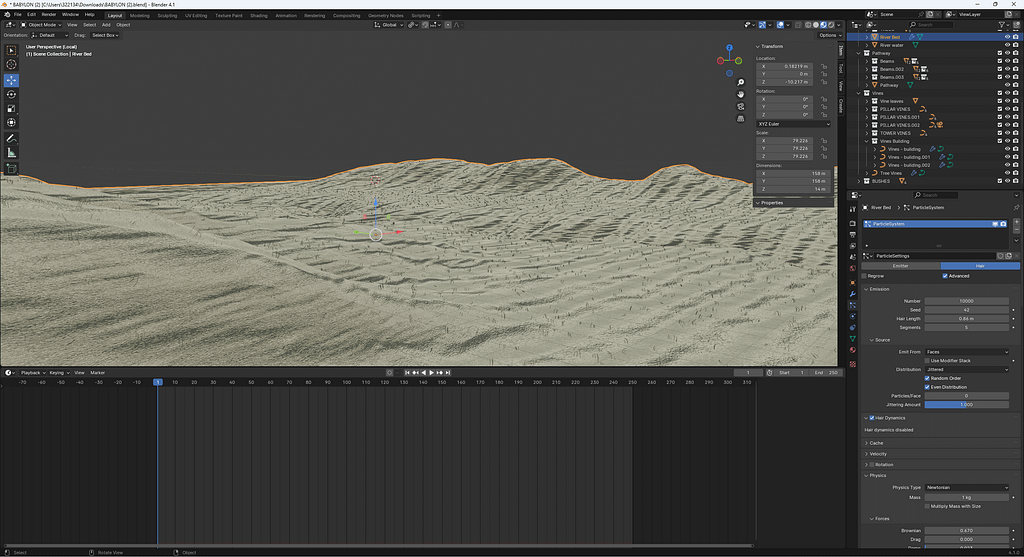
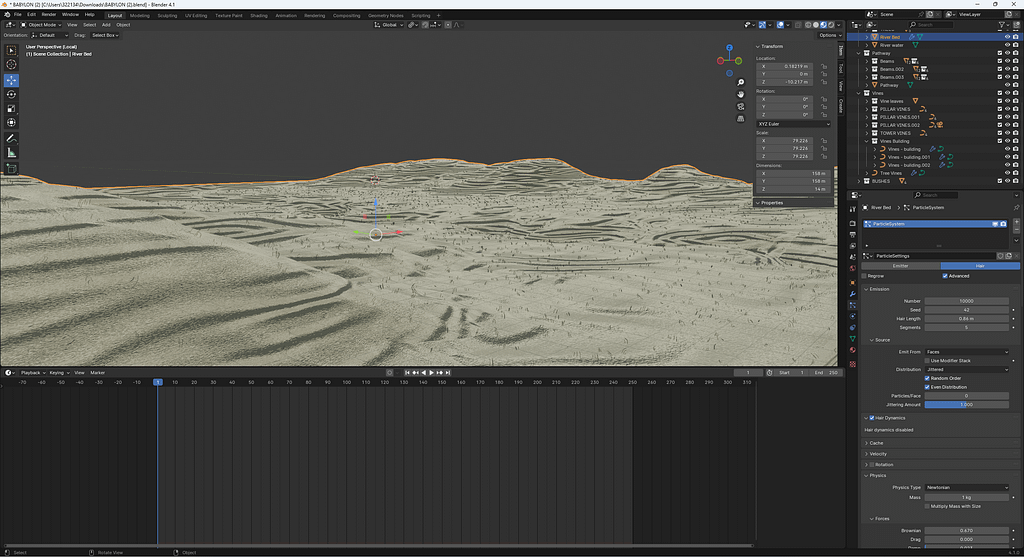
I then turned my attention to creating the texture for the river water. I used the same textures as the landscape but altered the scale and texture as dunes because they have very similar wave patterns, I also made it more reflective to add the shine of the water to it.
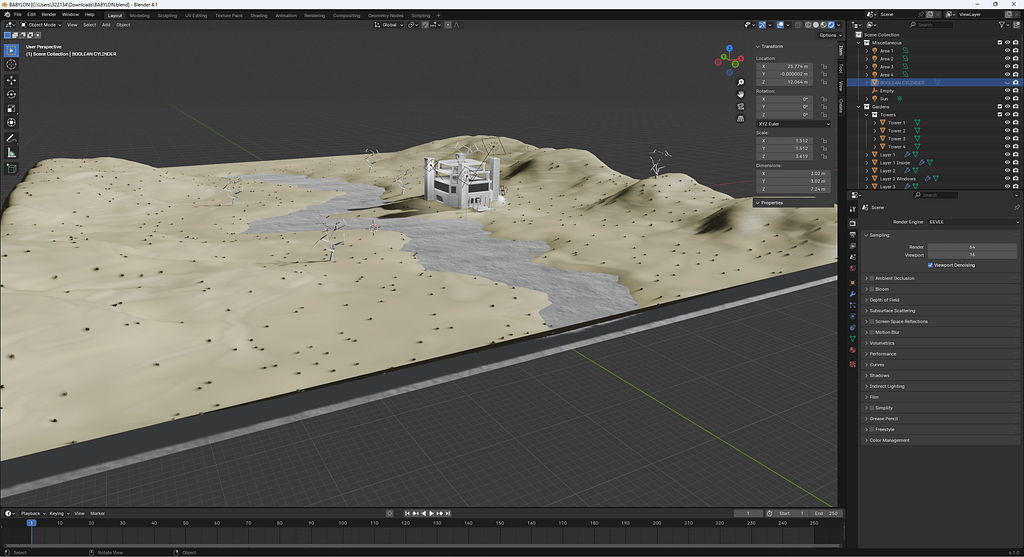
One I was happy with the river, I began creating the dead trees in the environment. I approached this by first creating a cube, I then merged all the vertices together and drew the main structure of the tree with its branches. I then added a skin modifier as well as a subdivision modifier to add more detail. Once I was happy with my first tree I placed a few around the landscape including adding a much larger one within the gardens. I then added hair modifiers to the one in the garden which helped create the leaves and also improve my understanding of particle physics.
In my opinion I believe that I excel in the texture creation with Blender as well as a strength in particle physics. My modelling can most definitely be improved as the topology of the building is very random and the vertices prove difficult to unwrap.
The following week I began working on vines. I started modelling out the leaf based on my research of how vine leaves look. I created a simple low poly leaf which I would then export the UV and create a texture for the leaf. Below is my Model produced which will be vital in any vine I create.
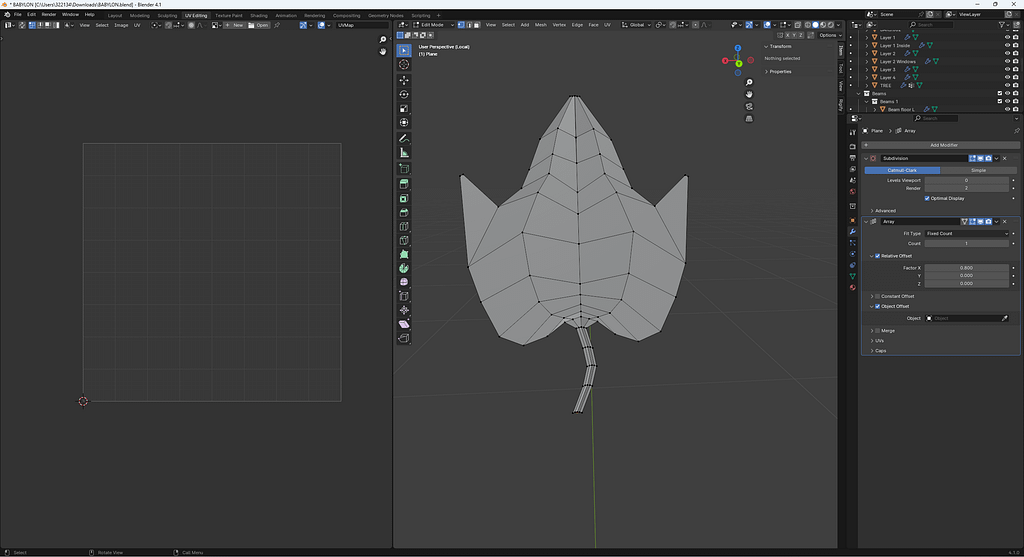

Afterwards I created the texture in Photoshop and exported it back to Blender. It used simple colours for better contrast but I knew that I didn’t need a lot of detail as the scale of the vines would be extremely small compared to the building itself.
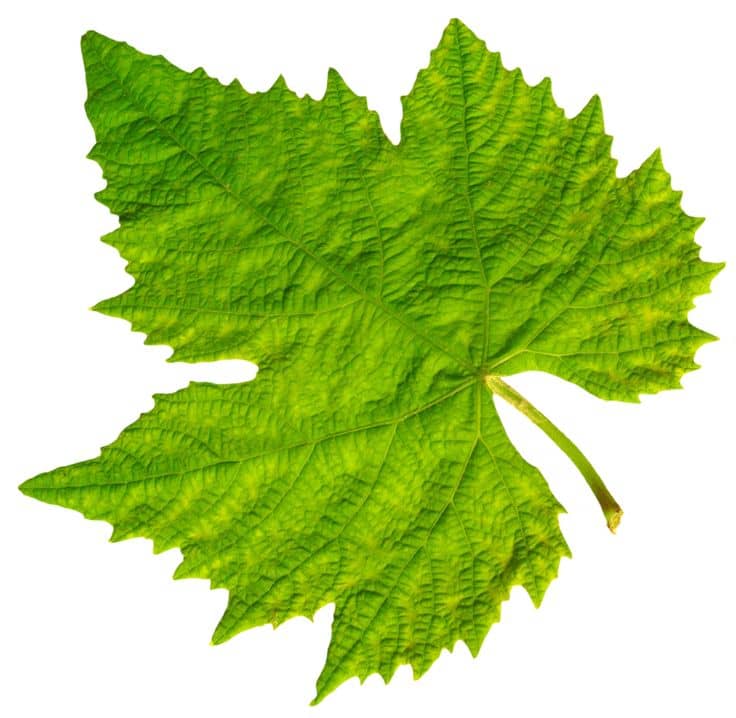

I then created a Bezier curve, which I warped and adjusted around the towers; pillars; and the building itself, and added geometry nodes to increase its thickness as well as adding a collection info node to emit the leaves from the face. Below is a photo of the vines with the nodes included.
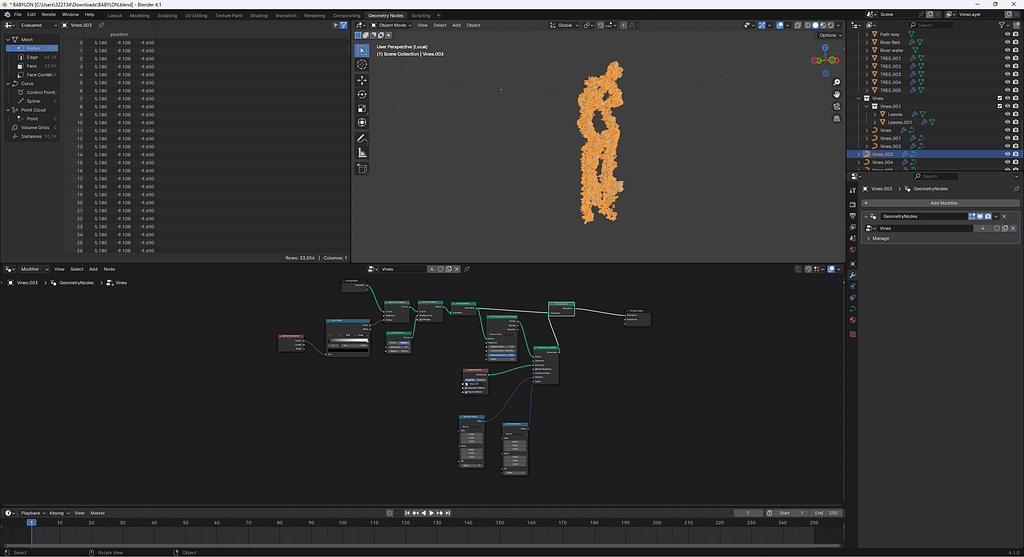
Finally, I implemented them across the towers and beams to create an overgrown and abandoned style which was recommended by my friend. Here is the image of how it looks currently with the product. I will most likely alter it in the future as I believe the style of the leaves are too bright and uncanny in a desert environment.
I also added the mud-brick texture. I used the same texture as the sand landscape but darkened some of the tones in correlation to my research earlier on with the materials used. and added a brick node which created the illusion of bricks. I encountered some issues with the texture generation due to the topology of the structure as well as the mortar size. the errors I encountered are shown below.
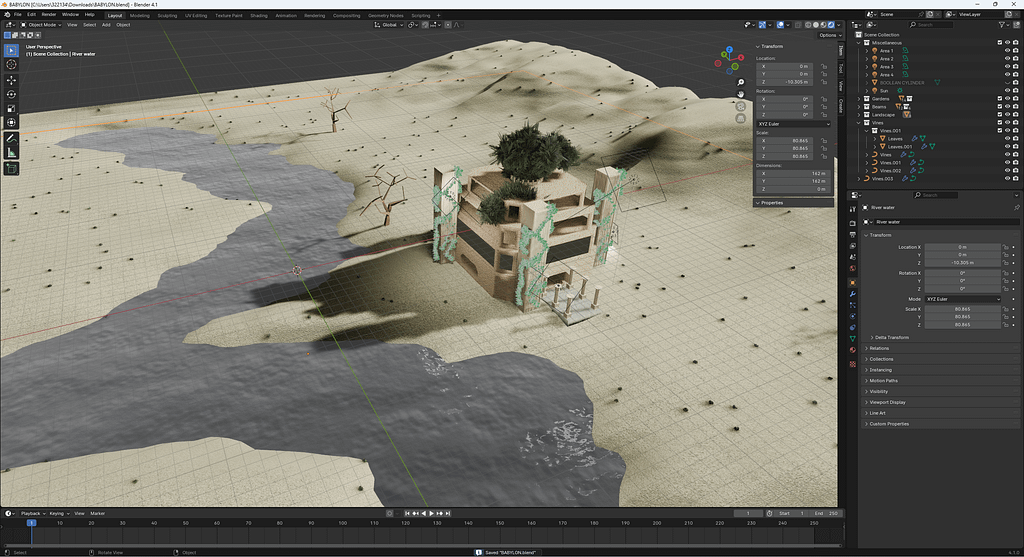
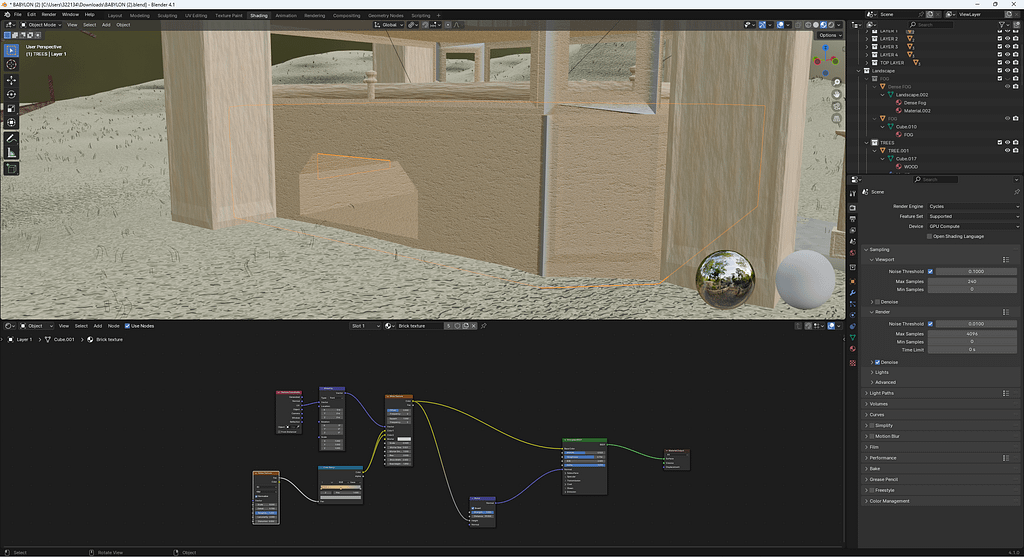
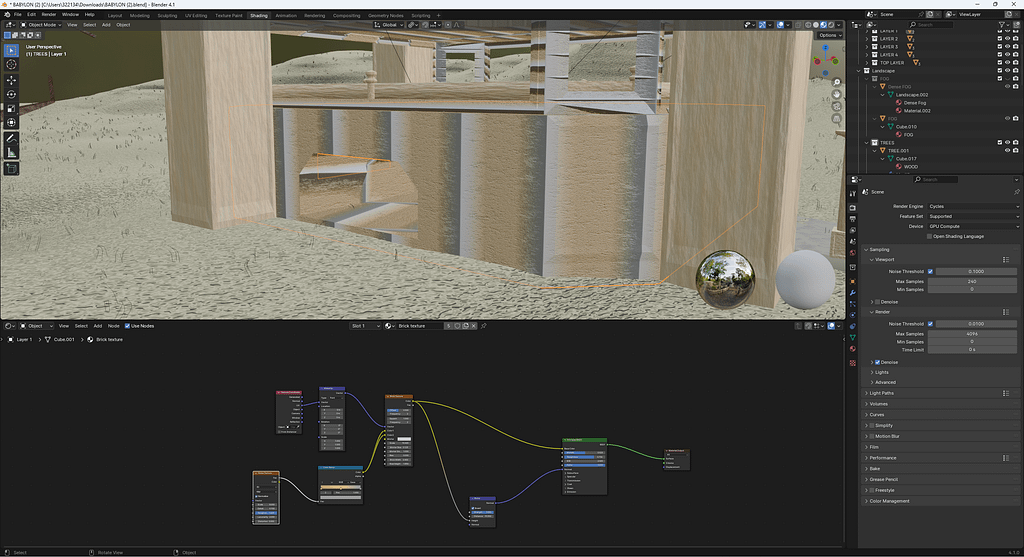
WWW: My ability to create intricate models of vines and their leaves as well as creating realistic wrapping around the towers.
EBI: If I could improve the texture with the UV mapping by adding a realistic style instead of a simplistic style as well as implementing more leaves into the texture to add variety.
Rendering and Final Touches.
6 April 2024
With all the work completed over the last 9 weeks I entered week 10 with the task to render my work out. I was expecting to encounter slow render times and errors when rendering due to the length of footage I am rendering as well as the particle count and mesh count taking a large usage of cpu and gpu power.
Unfortunately my worries were even worse than what I had hoped would be the problem. When I did my first test render, one frame took approximately 13 minutes and 43 seconds to render. This meant that with the 640 frames that I would be rendering it would take 6 days, 2 hours, 18 minutes and 40 seconds to render the entire product out! This was not enough time and If the render suddenly stopped or got corrupted It would mean that I would not have a finished product for the FMP.
With this knowledge I decided to scale back my particle physics as I believed that it was the issue with the rendering time. I halved all the particles which reduced the render time down to 2 minutes for each frame but that still wasn’t enough so I had to reduce them even more. Eventually I reached 30 seconds for each frame which is still slow but it gives me more time to render and tune any parts if I decide that I want to change some features. It frustrated me that I couldn’t include all the detail I had before but unfortunately the systems used wouldn’t be able to handle my product.
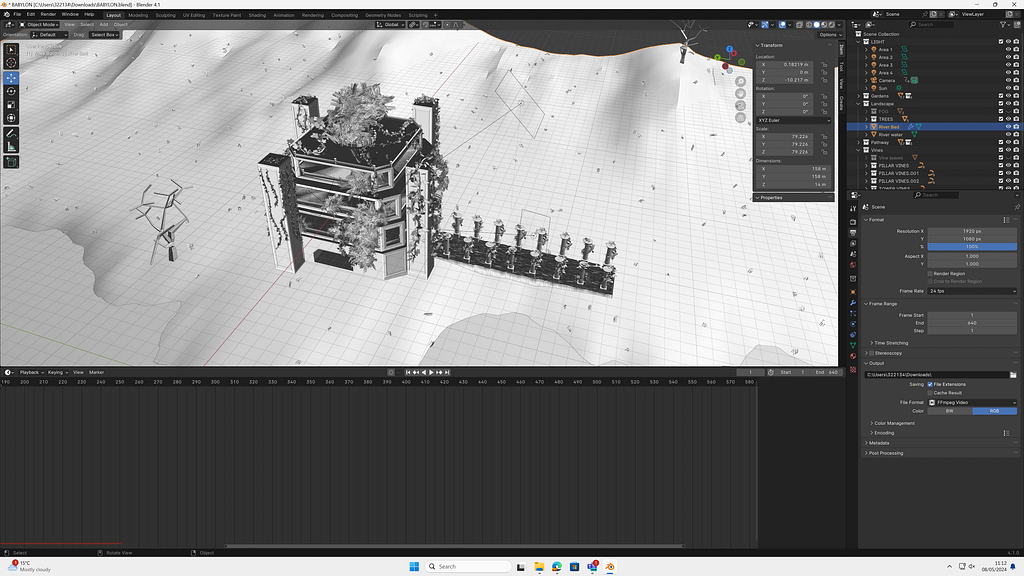
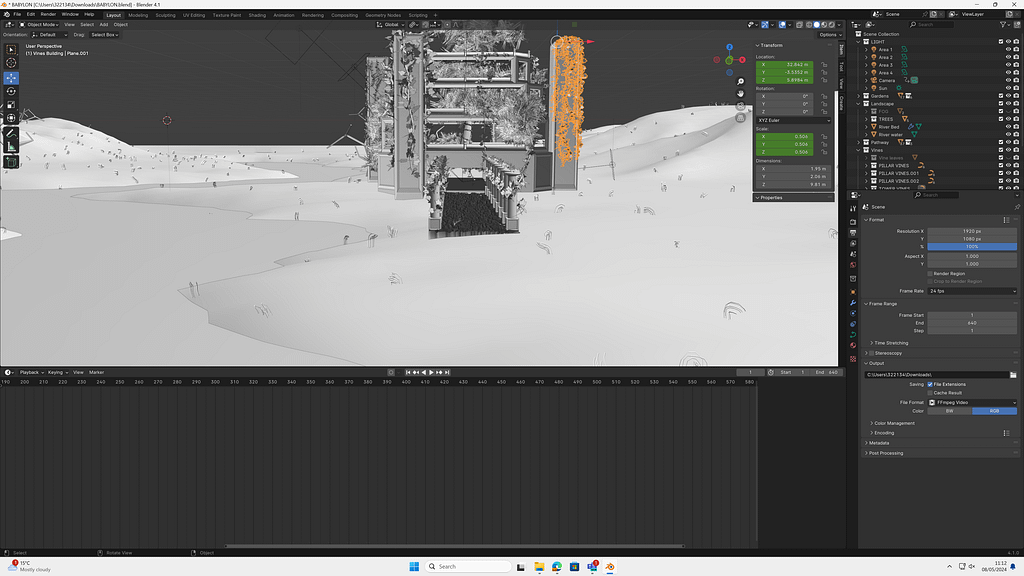
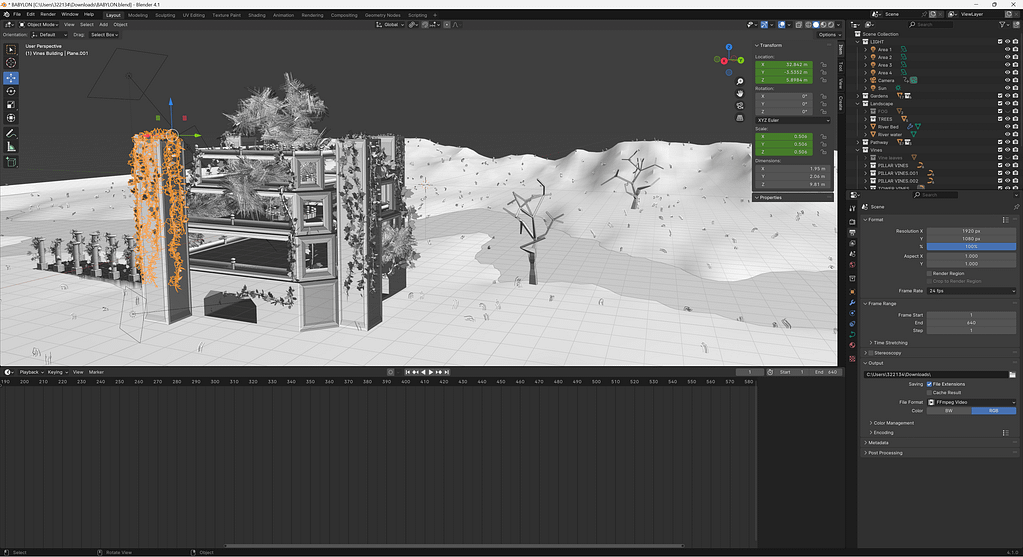


With all the adjustments made I managed to render it out. Unfortunately it still took quite some time to fully render out, 16 hours in total – rendering started at 9am and finished at 1am the following day.
I do wish, however, I was able to use my first settings with the render as It would have been highly detailed and would have looked amazing as the flora would have been lush and green and abundant with life but the limitations with my system made it impossible for me to do it. Fortunately though, I managed to get some rendered images of my original ideas of which took around 30 minutes to render each. Below the render is a compilation of the first ideas I produced and had hoped would be rendered for the final product.
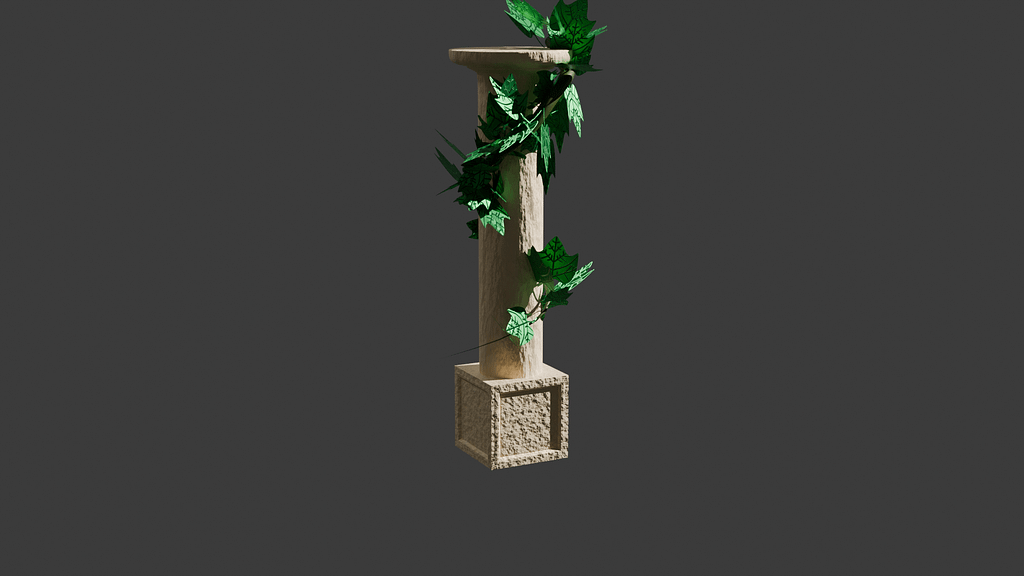
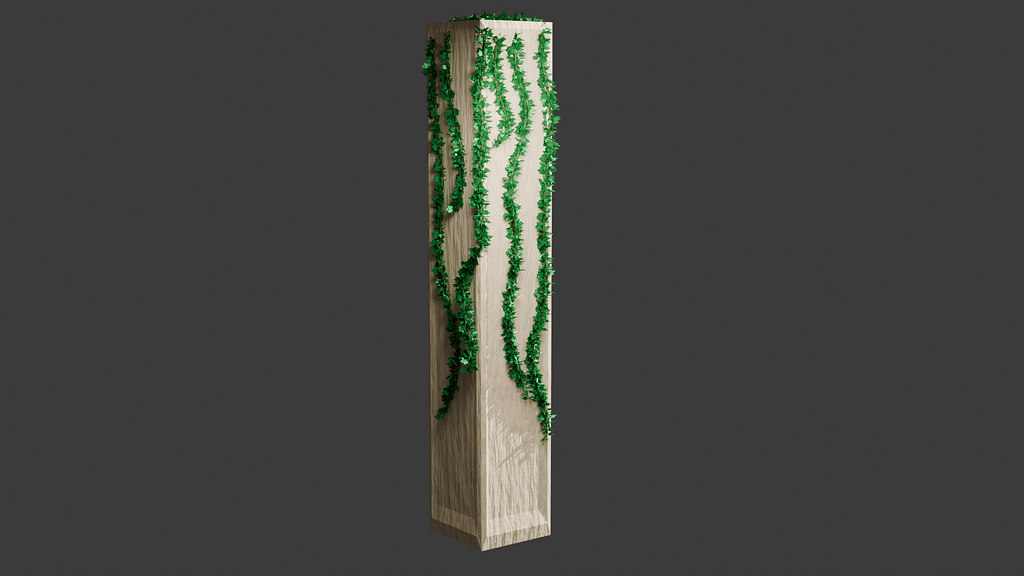
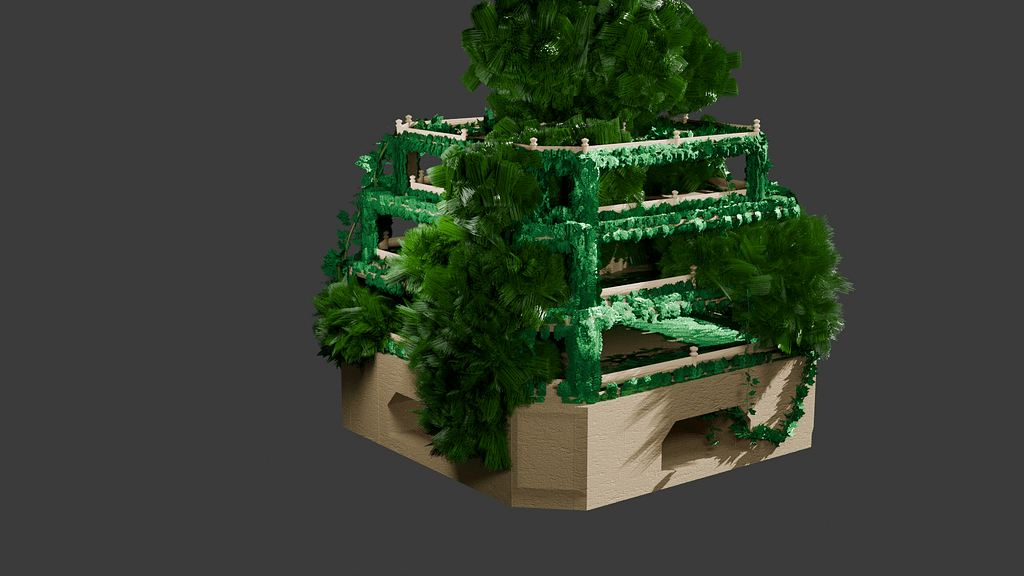

The final outcome was not as I hoped although I am satisfied with the final render as it still pertained to the original ideas and concepts I had hoped for just at a smaller scale.
Evaluation & Conclusion
8 May 2024
Within this section I am going to critically analyse my product, the processes, and the steps to achieving the final piece.
Research Stage Evaluation
Throughout the research stage I found it difficult to find resources that differed greatly from each other. I constantly found myself re-reading the same bits of information about The Gardens of Babylon and its history. whilst I enjoyed the research stage, I was frustrated by the lack of representation within modern media. This, however, motivated me into producing the piece of media even more. I felt my primary research went well and although restricted to college peers and other people I know, including my parents, I was able to include people from a number of different backgrounds as I had hoped. This gave me a really good insight into peoples perceptions of the Hanging Gardens of Babylon that supported my own vision.
Moving forward, I believe I should be asking more people to get a much more varied response, however because of the subject matter and mystery of the gardens I feel the responses would have been very similar nonetheless.
Pre-Production Evaluation
I was correct in recognising the challenges I would face. My ambitious vision was always going to be a challenge and unfortunately computer limitations became the primary inhibitor to realising my vision this time. With render times exceeding 16 hours I was forced to make hard decisions about the complexity and detail of my product which was disappointing. I also found myself easily distracted with finessing however I was pleased with some of the outcomes that it produced which meant I was able to keep them in the production such as the vine leaves. Whilst drawing isn’t my strongest skill and I struggled producing sketches and concepts from my minds eye, I still enjoy the process of sketching and creating digital concepts as a basis to my final product. It enabled me to wireframe very basic elements and designs to ensure I had a vision to work with.
Production Evaluation
As I enjoy the creative part, I was eager to start production as soon as possible and it could result in a very computer resource heavy product due to the scale and detail I wanted to include. This particular period of my FMP I found the easiest as my proficiency in Blender and the skills I have learnt in 3D modelling over the past 2 years have hugely improved. however, I still recognise I have a lot to learn, especially when it comes to meshing and particles that can produce results as well as being resource efficient. In hindsight I would have approached this slightly differently because of it’s scale and size to componentize to allow me to focus on individual elements better than the product as a whole.
Another hinderance due to performance related issues was the ability to experiment with different camera angles and motions. Given more time I would have liked to improve on this to really display my product in the best possible way, However, I am still happy with how the final render turned out.
Post Production & External Evaluation
The strengths I gained within the FMP included; UV unwrapping; shading; geometry nodes; landscape creation; hair particles; and concept art. These grew during the production as I learnt more about Blender and what its abilities are as well as how to efficiently create sketches that would provide useful aid when working within Blender itself.
I know I could have improved on increasing the detail in my sketches by adding colour and notes. I could have also attempted to create more detail within the product itself by adding more buildings and greenery but unfortunately I had limitations with the system that wouldn’t allow me to.
I showed the final render to a number of people, including my parents, who were quite impressed with the product. I asked them 2 questions:
- What do you like about my interpretation of the Hanging Gardens of Babylon?
- What do you think could be improved?
My Parents evaluation
They particularly liked the structure, foliage and the landscape of my interpretation of the Hanging Gardens of Babylon and the way the animation took you on a journey through the building.
“I really like the sense of drama in the way the camera angles take you along the landscape, through the columns and into the building”
They did also pointed out that there could have been more detail within the structure itself, possibly steps and larger terraces and perhaps more different types of foliage used too.
“I feel like there could be more diversity of plants and trees to really give it more impact”
Evaluation from peers within the course
They liked the style of the building and the detail within it. They also liked the use of camera animations and movements to showcase the product.
“I liked the building itself. I also liked the different paths you took with the camera to show the scale.”
They did point out however that there were issues with the textures and that the camera felt stiff and that it didn’t ease between each shot.
“It would be nice if the camera was less robotic. Also there was some texture flickering as well.”
Using this feedback and my own personal evaluation, if I could start from the beginning I would look to use more concept art, include more types of foliage in the render and allow more time rendering to get the high detailed version I had hoped for in enough time for the submission date.
To conclude on my FMP I believe that I made great progress through it all, yes there were challenges I encountered but throughout it I managed to still produce a piece of media on the theme of Mystery that I am happy with.
Sources
- Oxford English Dictionary. (14 march 2000). Mystery. [Online]. Oxford English Dictionary. Last Updated: 2023. Available at: https://www.oed.com/dictionary/mystery_n1?tab=meaning_and_use#35210965 [Accessed 27 Feb 2024].
- National Geographic Society. (2023). Seven Wonders of the Ancient World. [Online]. National Geographic. Last Updated: October 19 2023. Available at: https://education.nationalgeographic.org/resource/seven-wonders-ancient-world/ [Accessed 27 February 2024].
- Catherine Phelan. (2018). 7 Greatest Unsolved Mysteries of the World. [Online]. The Lineup. Last Updated: February 1 2018. Available at: https://the-line-up.com/7-greatest-unsolved-mysteries [Accessed 27 Feb 2024].
- Dr Jago Cooper. (2013). El Dorado: The truth behind the myth. [Online]. BBC. Last Updated: 14 Jan 2013. Available at: https://www.bbc.co.uk/news/magazine-20964114 [Accessed 27 Feb 2023].
- Bryan Nelson. (2019). 10 of the World’s Biggest Unsolved Mysteries. [Online]. TreeHugger. Last Updated: March 1 2019. Available at: https://www.treehugger.com/worlds-biggest-unsolved-mysteries-4869324 [Accessed 27 Feb 2024].
- Jess Blumberg. (2007). Abandoned Ship: The Mary Celeste. [Online]. Smithsonian Magazine. Last Updated: November 2007. Available at: https://www.smithsonianmag.com/history/abandoned-ship-the-mary-celeste-174488104/ [Accessed 27 Feb 2023].
- Bryan Nelson. (2019). 10 of the World’s Biggest Unsolved Mysteries. [Online]. TreeHugger. Last Updated: March 1 2019. Available at: https://www.treehugger.com/worlds-biggest-unsolved-mysteries-4869324 [Accessed 29 Feb2024].
- Discovery. (2022). What is the Phaistos Disc and What Does it Mean?. [Online]. Discovery. Last Updated: 17 may 2022. Available at: https://www.discoveryuk.com/mysteries/what-is-the-phaistos-disc-and-what-does-it-mean/ [Accessed 28 Feb 2023].
- Steve Pitt. (2012). Windigo. [Online]. The Canadian Encyclopedia. Last Updated: March 18 2018. Available at: https://www.thecanadianencyclopedia.ca/en/article/windigo [Accessed 28 Feb 2023].
- History. (2023). WHAT IS A SKINWALKER? FACTS ABOUT THE NATIVE AMERICAN LEGEND. [Online]. History. Available at: https://www.history.co.uk/articles/from-skinwalkers-to-wendigos-4-native-american-myths-and-legends [Accessed 28 Feb 2023].
- The Editors of Encyclopædia Britannica. (Jul 20 1998). Atlantis. [Online]. Britannica. Last Updated: October 10 2023. Available at: https://www.britannica.com/topic/Atlantis-legendary-island [Accessed 29 Feb 2023].
- Dave Roos. (2021). Where was Babylon and does it still exist?. [Online]. Howstuffworks. Last Updated: 20 October 2021. Available at: https://history.howstuffworks.com/history-vs-myth/babylon.htm [Accessed 14 March 2024].
- History.com Editors. (2018). Babylon. [Online]. History. Last Updated: May 31 2023. Available at: https://www.history.com/topics/ancient-middle-east/babylon#walls-of-babylon [Accessed 14 march 2024].
- Mark Cartwright. (2018). Hanging Gardens of Babylon. [Online]. World History Encyclopedia. Last Updated: 27 July 2018. Available at: https://www.worldhistory.org/Hanging_Gardens_of_Babylon/ [Accessed 14 march 2024].
- History.com Editors. (2018). Babylon. [Online]. History. Last Updated: May 31 2023. Available at: https://www.history.com/topics/ancient-middle-east/babylon#tower-of-babel [Accessed 14 march 2024].
- Elizabeth Snodgrass. (2013). The Hanging Gardens of … Nineveh?. [Online]. National Geographic. Last Updated: May 31 2013. Available at: https://www.nationalgeographic.com/science/article/130531-babylon-hanging-gardens-nineveh-seven-wond [Accessed 14 March 2024].
- Lumen Learning. (2021). Babylonian Culture. [Online]. Lumen Learning. Available at: https://courses.lumenlearning.com/suny-hccc-worldcivilization/chapter/babylonian-culture/#:~:text=Ba [Accessed 15 march 2024].
- Trees and shrubs online. (2020). Cedrus. [Online]. Trees and shrubs online. Available at: https://www.treesandshrubsonline.org/articles/cedrus/ [Accessed 118 March 2024].
- Praveen Varghese Thomas. (2023). Art of the Babylonians: Style, Examples & Achievements. [Online]. Tutorials Point. Last Updated: 28 Feb 2023. Available at: https://www.tutorialspoint.com/art-of-the-babylonians-style-examples-and-achievements#:~:text=Babylo [Accessed 18 march 2024].
- Rachel Campbell. (2017). Plants & Flowers in Iraq. [Online]. Garden Guides. Last Updated: 21 September, 2017. Available at: https://www.gardenguides.com/122798-plants-flowers-iraq.html [Accessed 19 March 2024].
- Marvel Cinematic Universe Wiki. (2021). Babylon. [Online]. Marvel Cinematic Universe Wiki. Last Updated: June 23 2023. Available at: https://marvelcinematicuniverse.fandom.com/wiki/Babylon [Accessed 19 march 2024].
- IMDB. (2009). Babel Rising. [Online]. IMDB. Available at: https://www.imdb.com/title/tt28870327/ [Accessed 20 march 2024].

